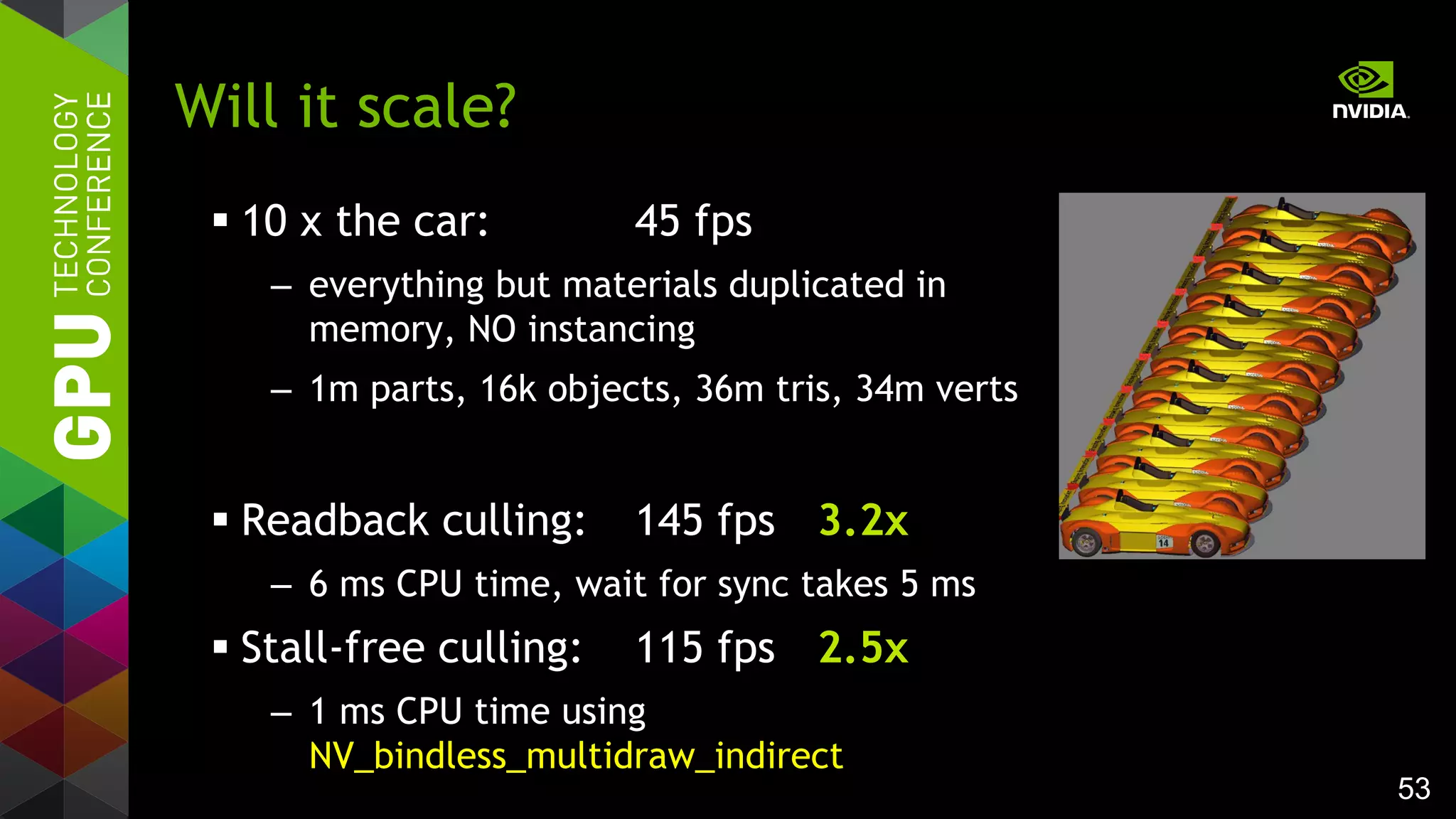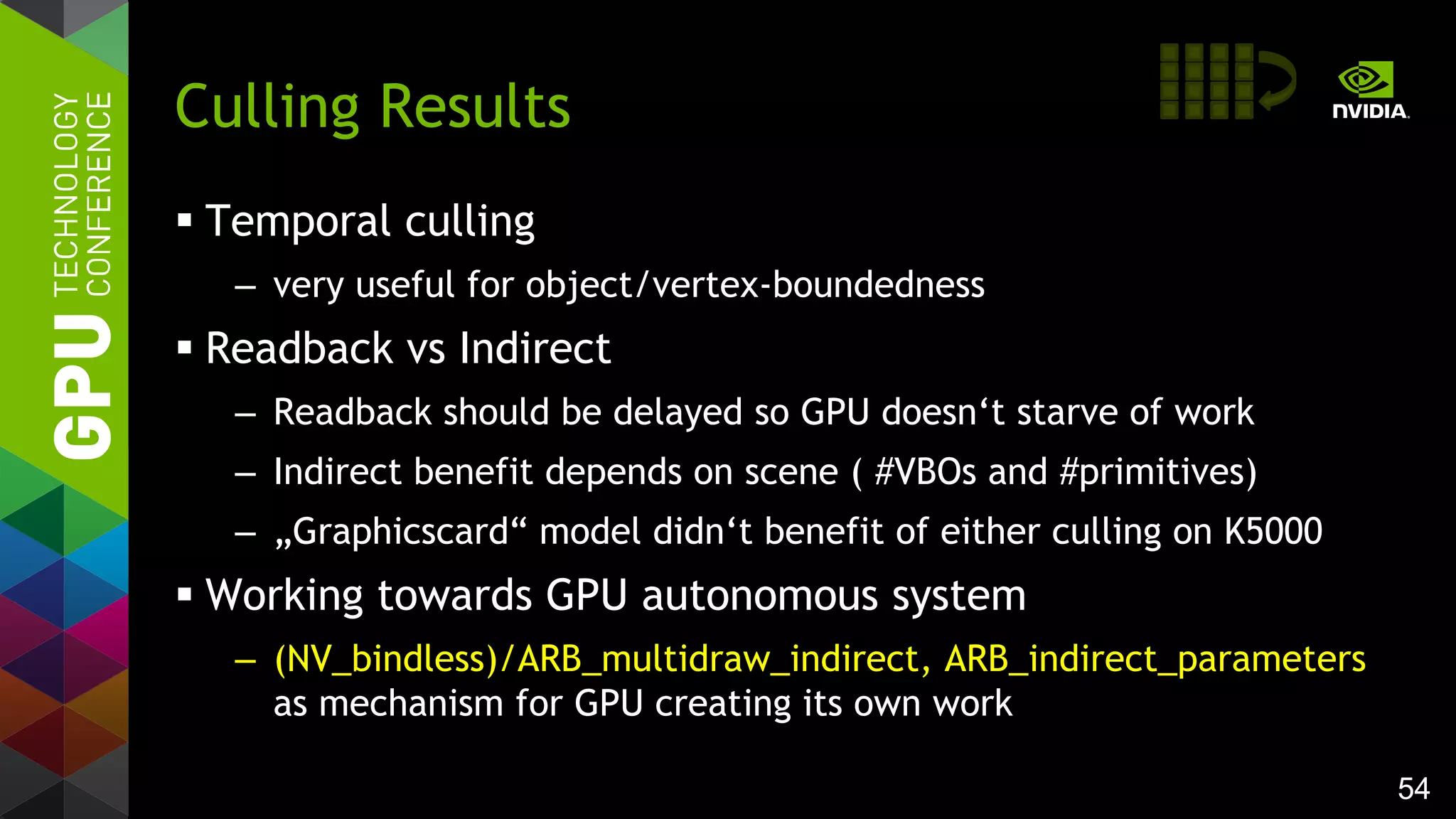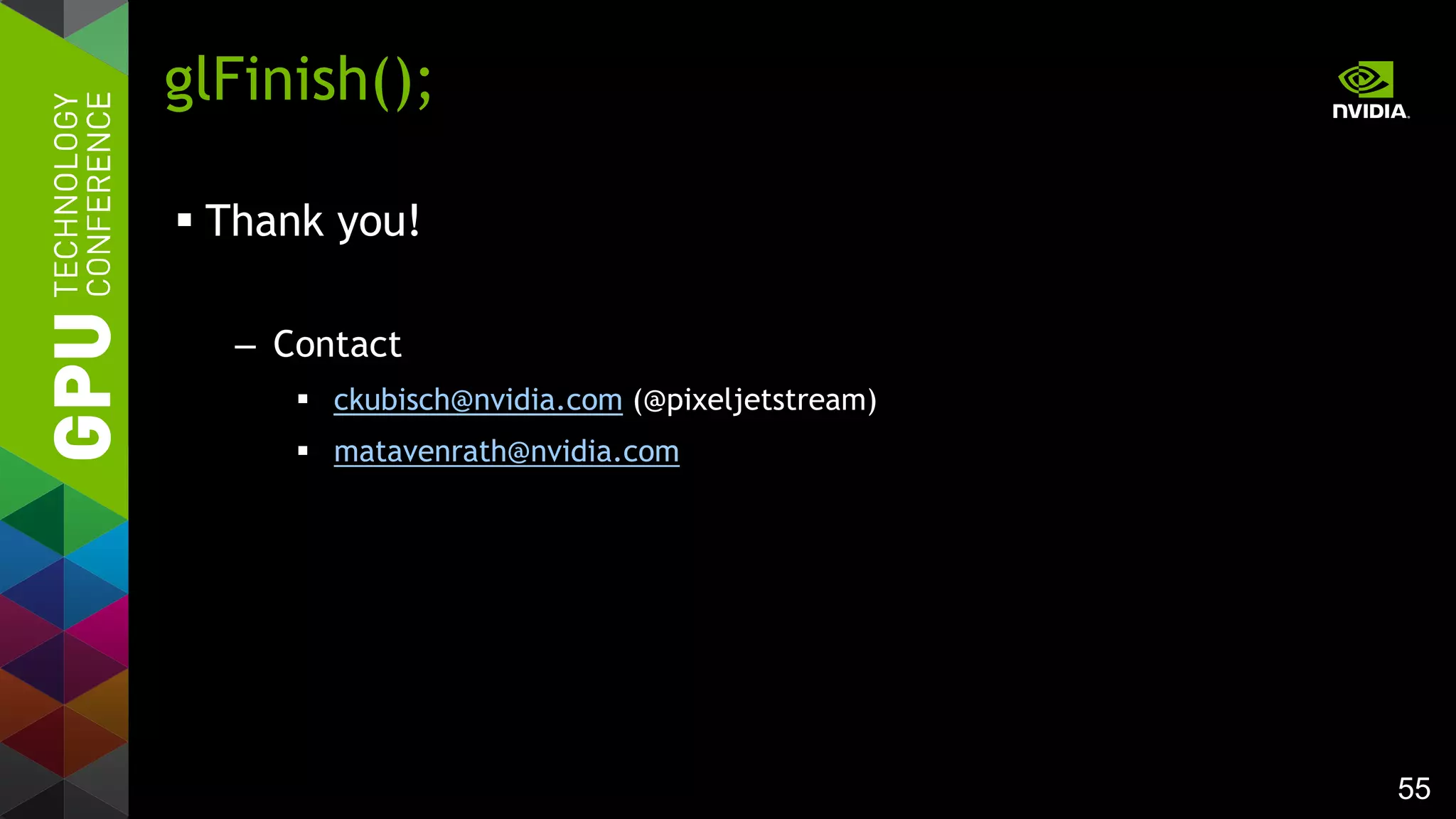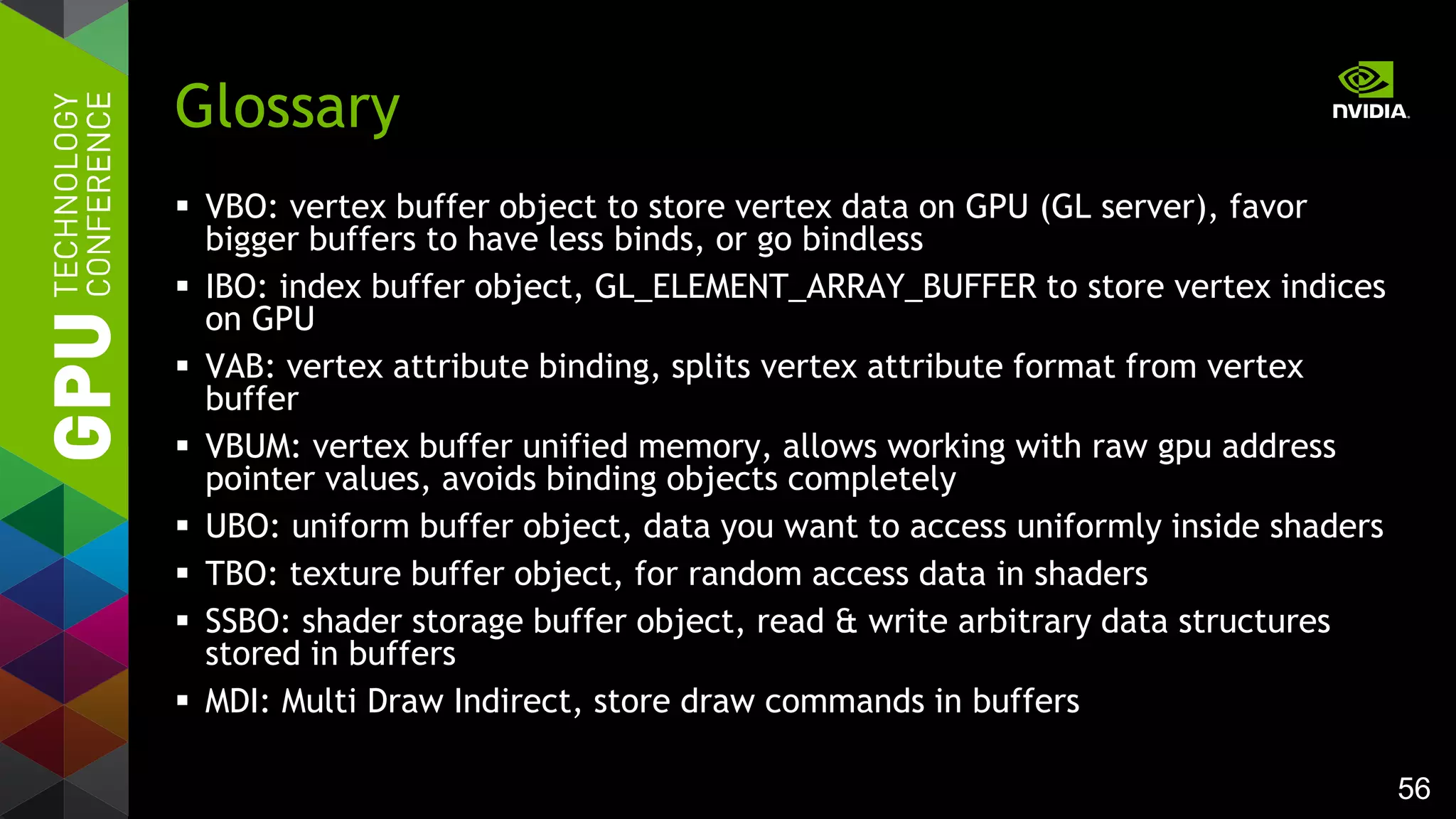The document discusses advanced OpenGL 4.4 scene rendering techniques, addressing challenges in rendering complex scenes due to high triangle counts and increased CPU bottlenecks. It outlines strategies to optimize performance by minimizing CPU/GPU interactions, avoiding data redundancy, and utilizing GPU-based culling and multi-draw indirect methods. Benchmarks show significant performance improvements, with reductions in rendering times through efficient batching and reduced API calls.
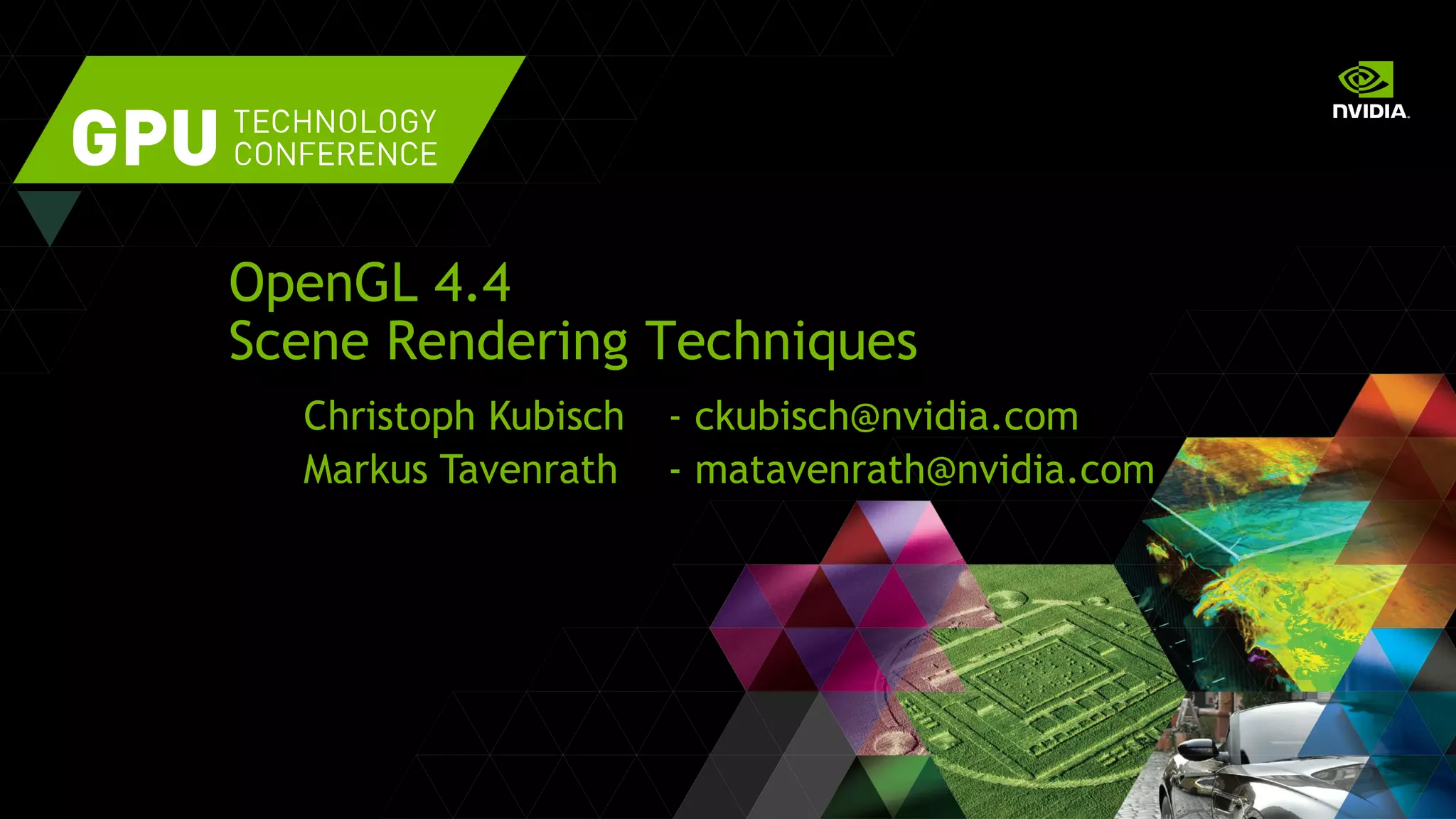
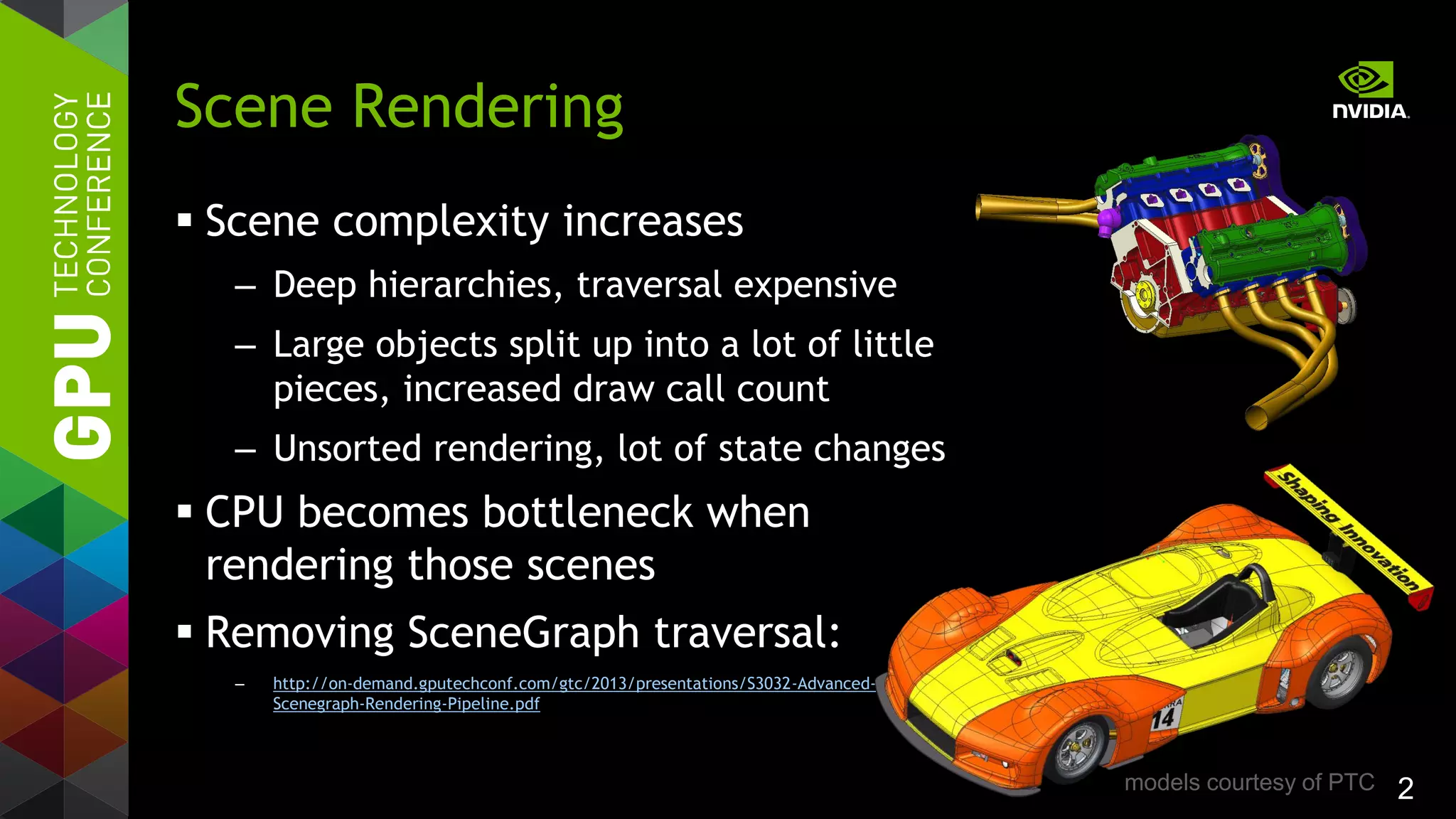
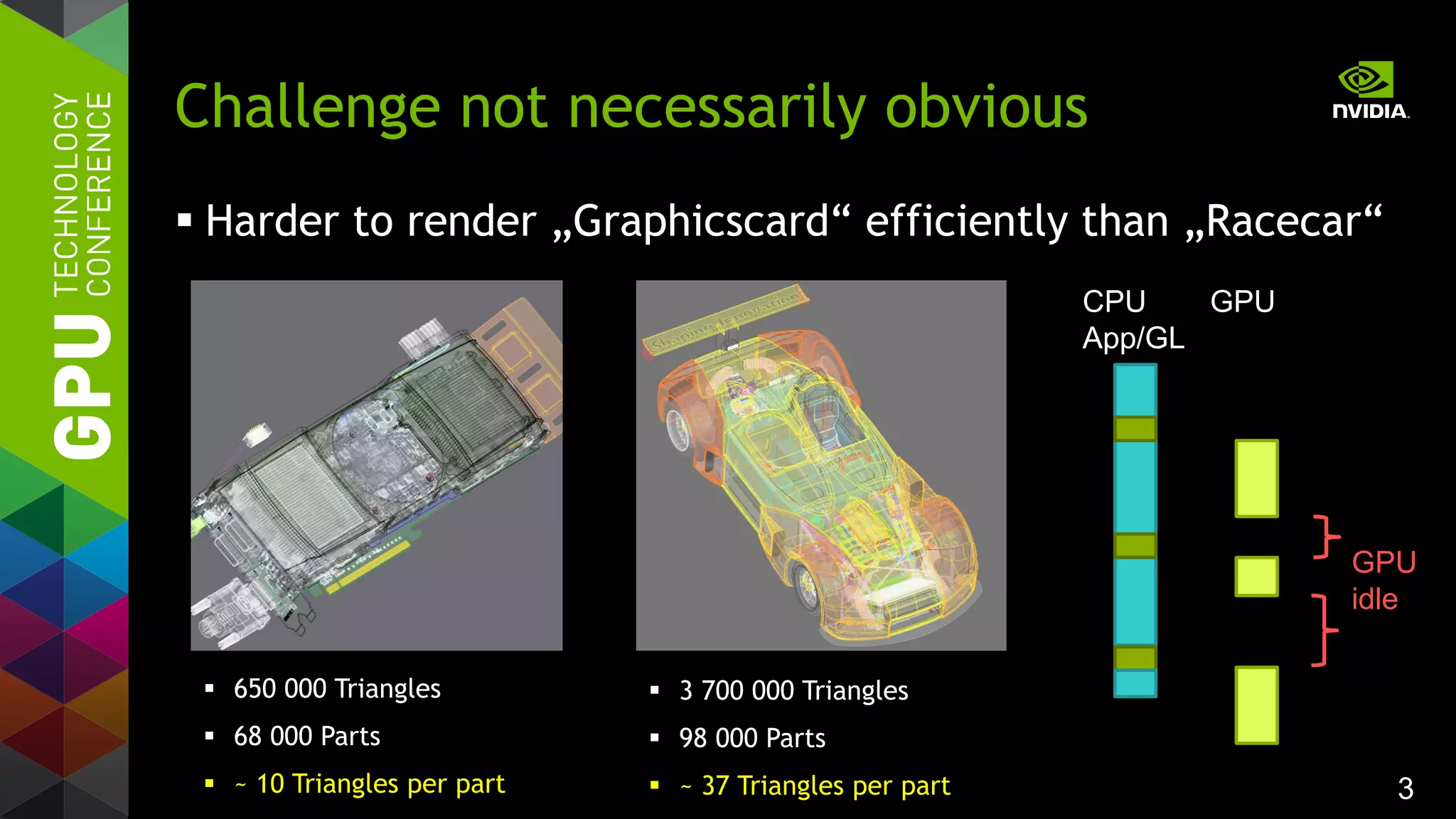

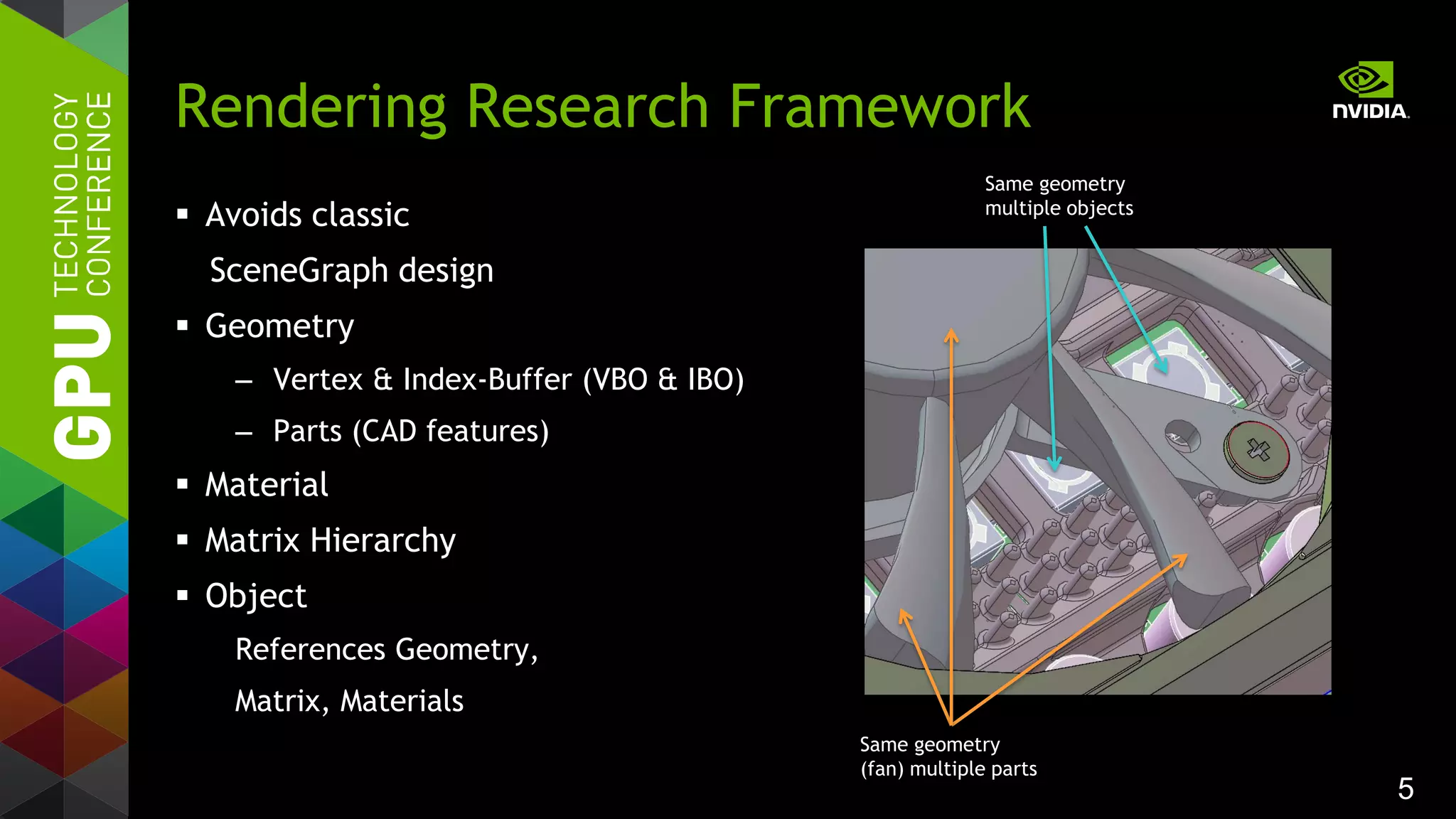


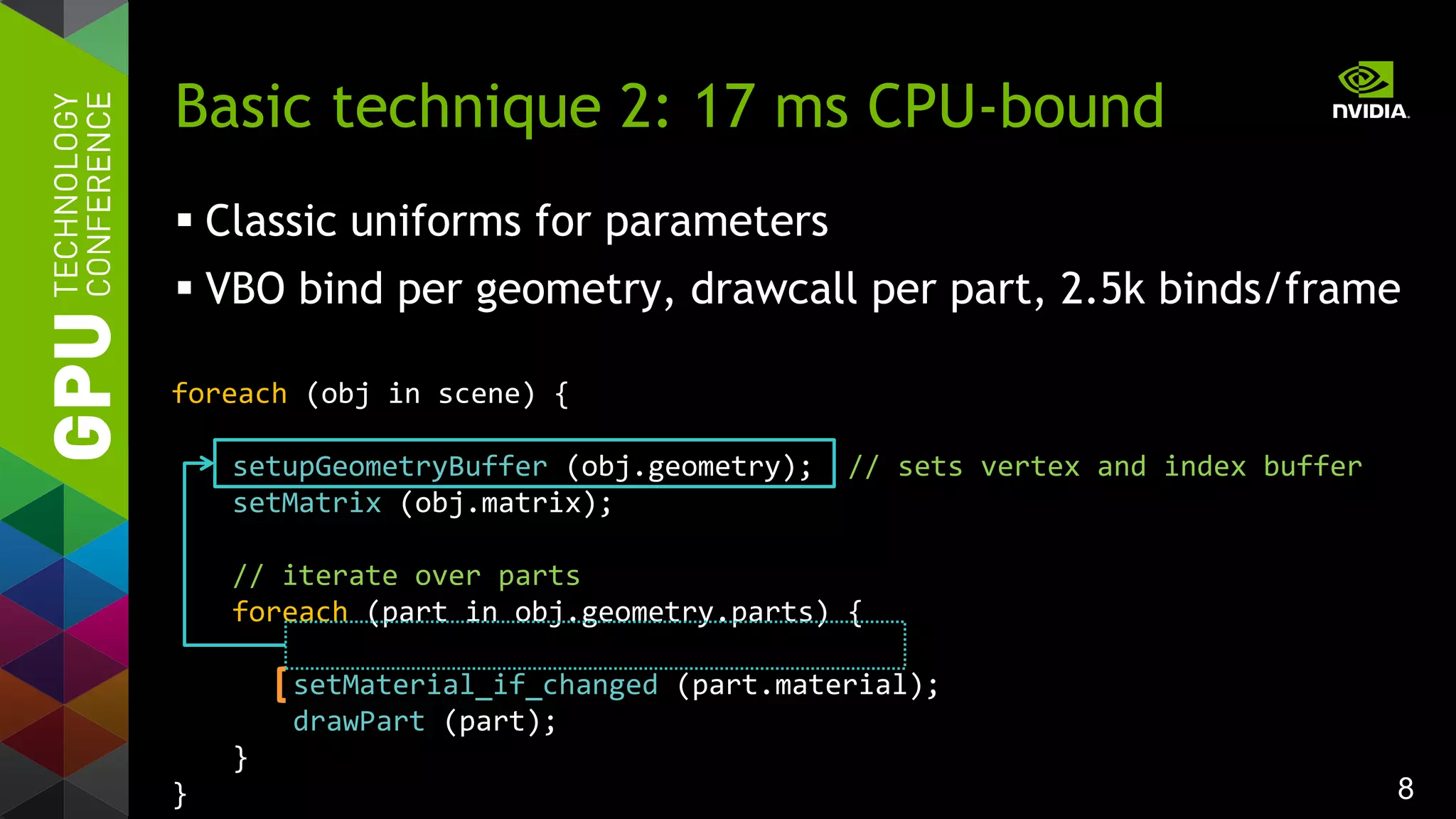
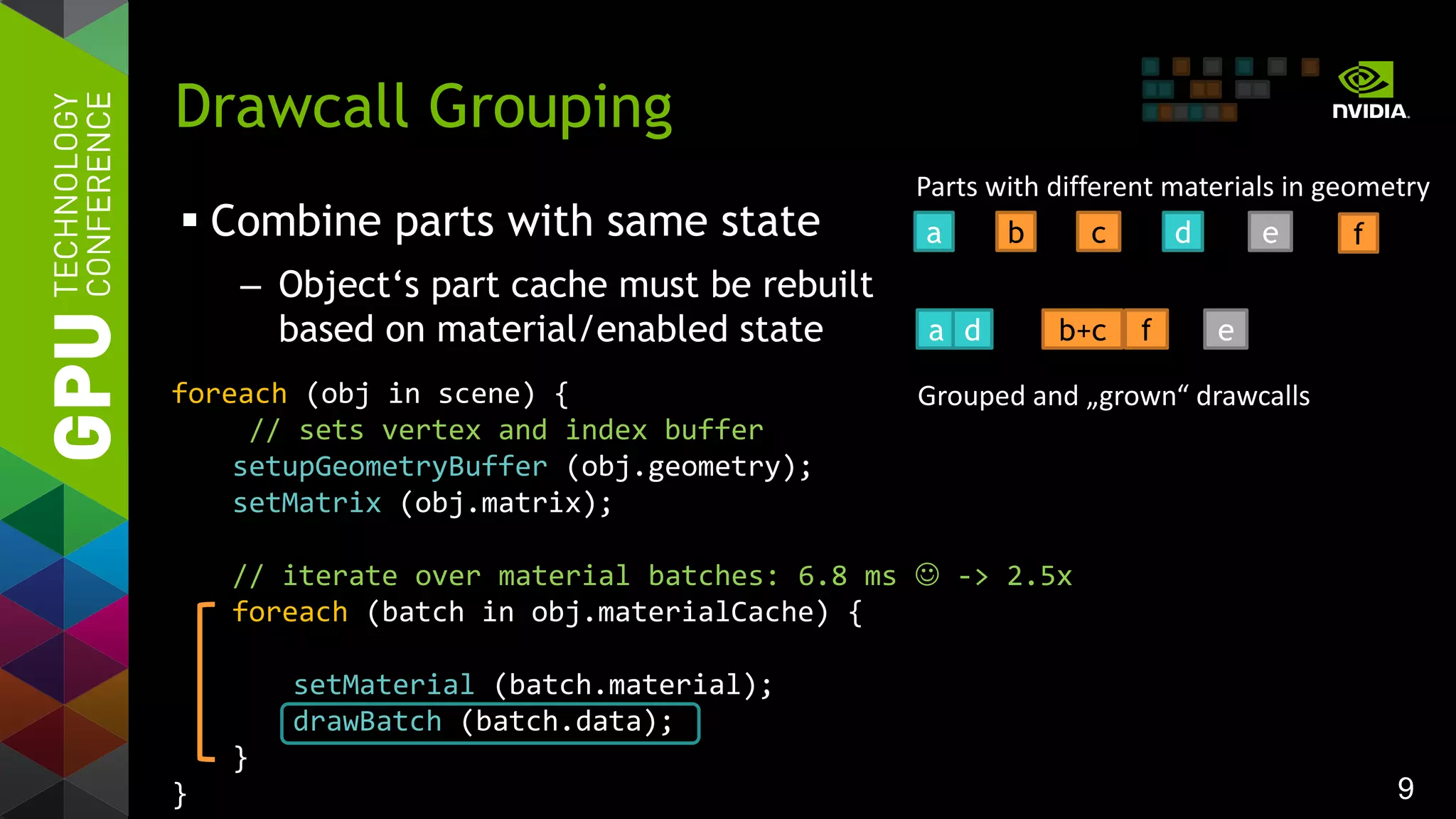
![10
drawBatch (batch) { // 6.8 ms
foreach range in batch.ranges {
glDrawElements (GL_.., range.count, .., range.offset);
}
}
drawBatch (batch) { // 6.1 ms -> 1.1x
glMultiDrawElements (GL_.., batch.counts[], .., batch.offsets[],
batch.numRanges);
}
glMultiDrawElements supports
multiple index buffer ranges
glMultiDrawElements (GL 1.4)
a b c d e f
a b+c fd e
offsets[] and counts[] per batch
for glMultiDrawElements
Index Buffer Object](https://image.slidesharecdn.com/tuq9luulsosocsjbihx7-signature-3a2a87be8e63e1de55b788f7f79aaa7579735627c4872928bfa368ed8b08f16a-poli-150113234003-conversion-gate02/75/OpenGL-4-4-Scene-Rendering-Techniques-10-2048.jpg)
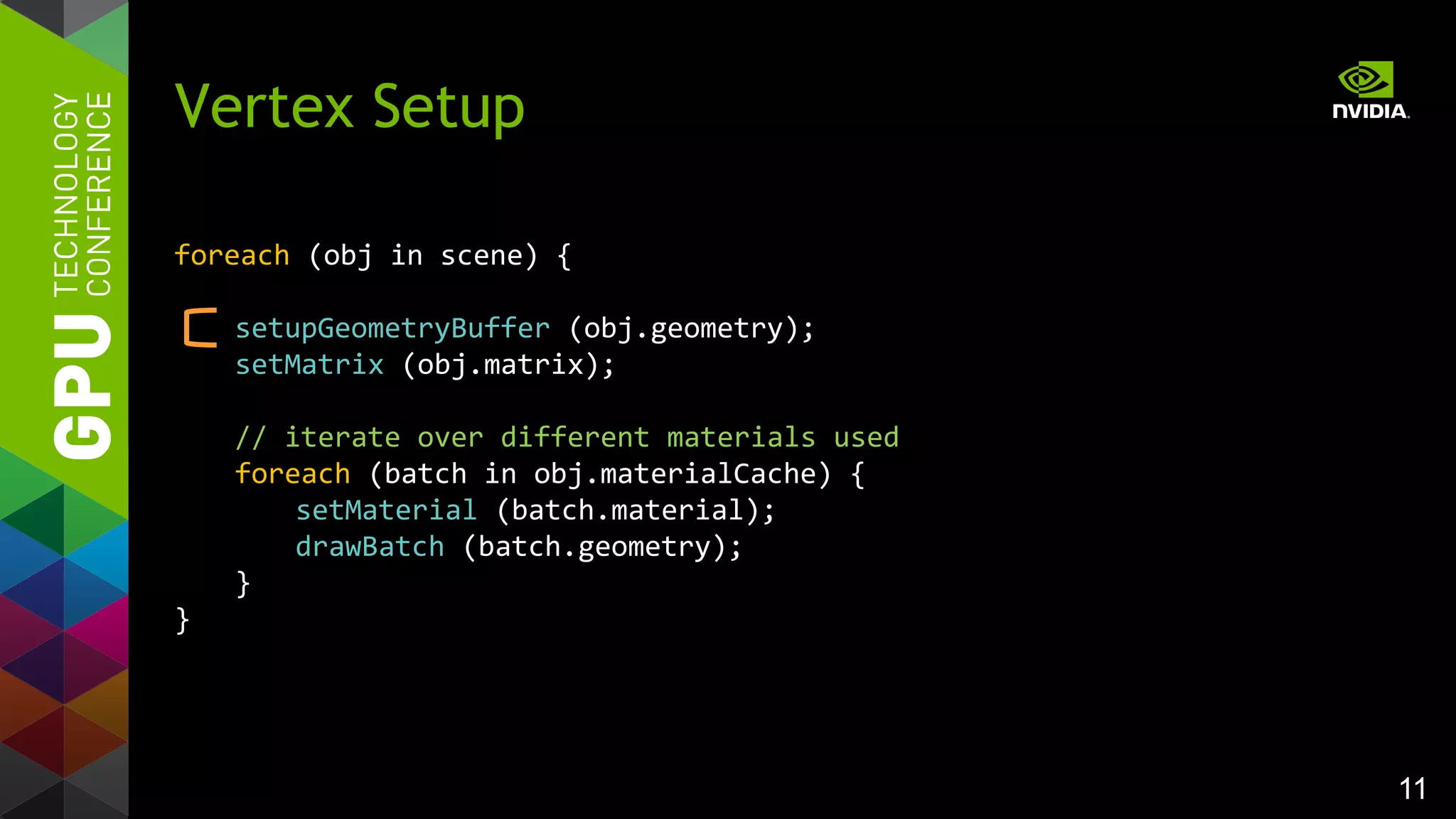

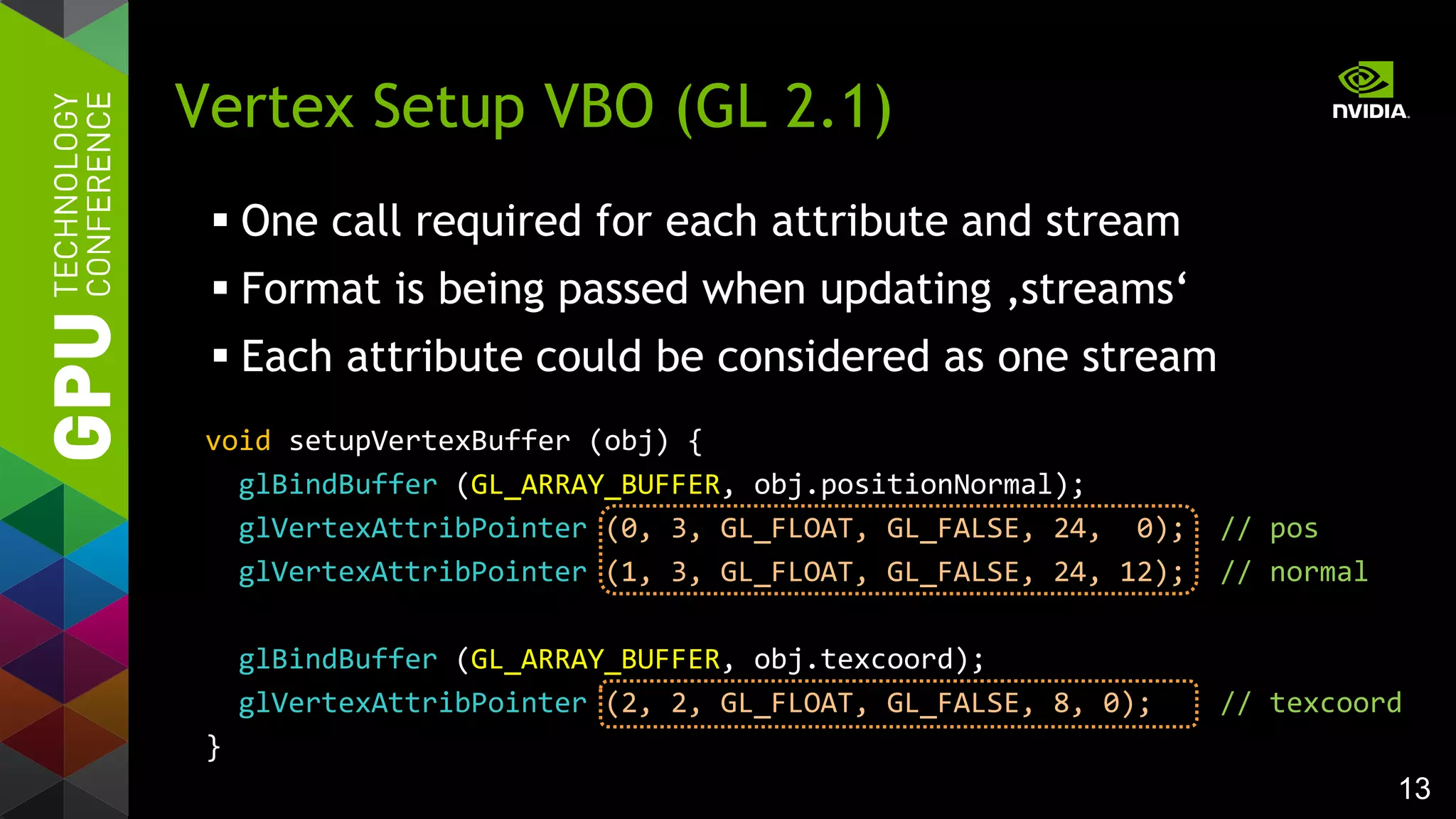
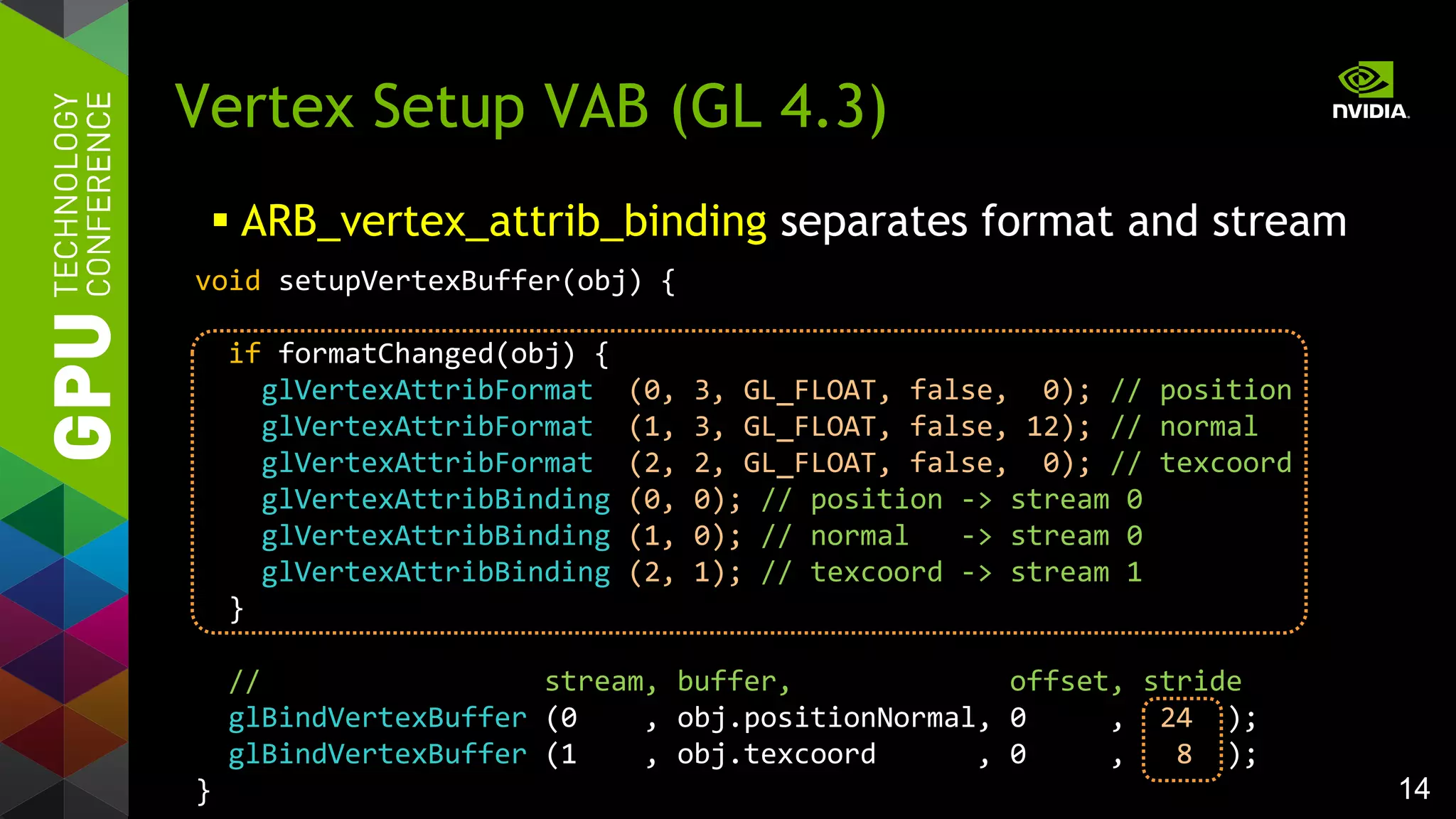
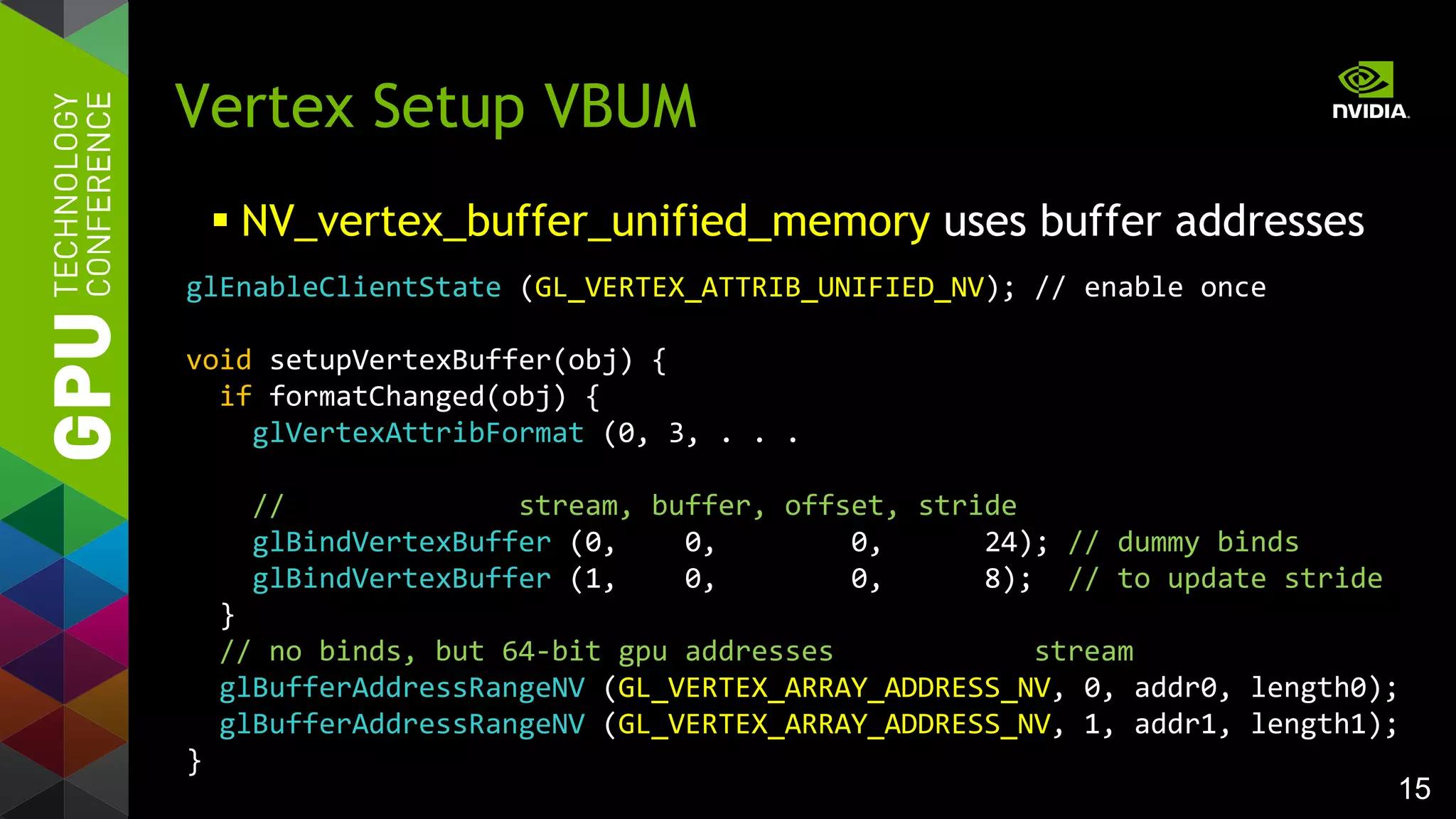
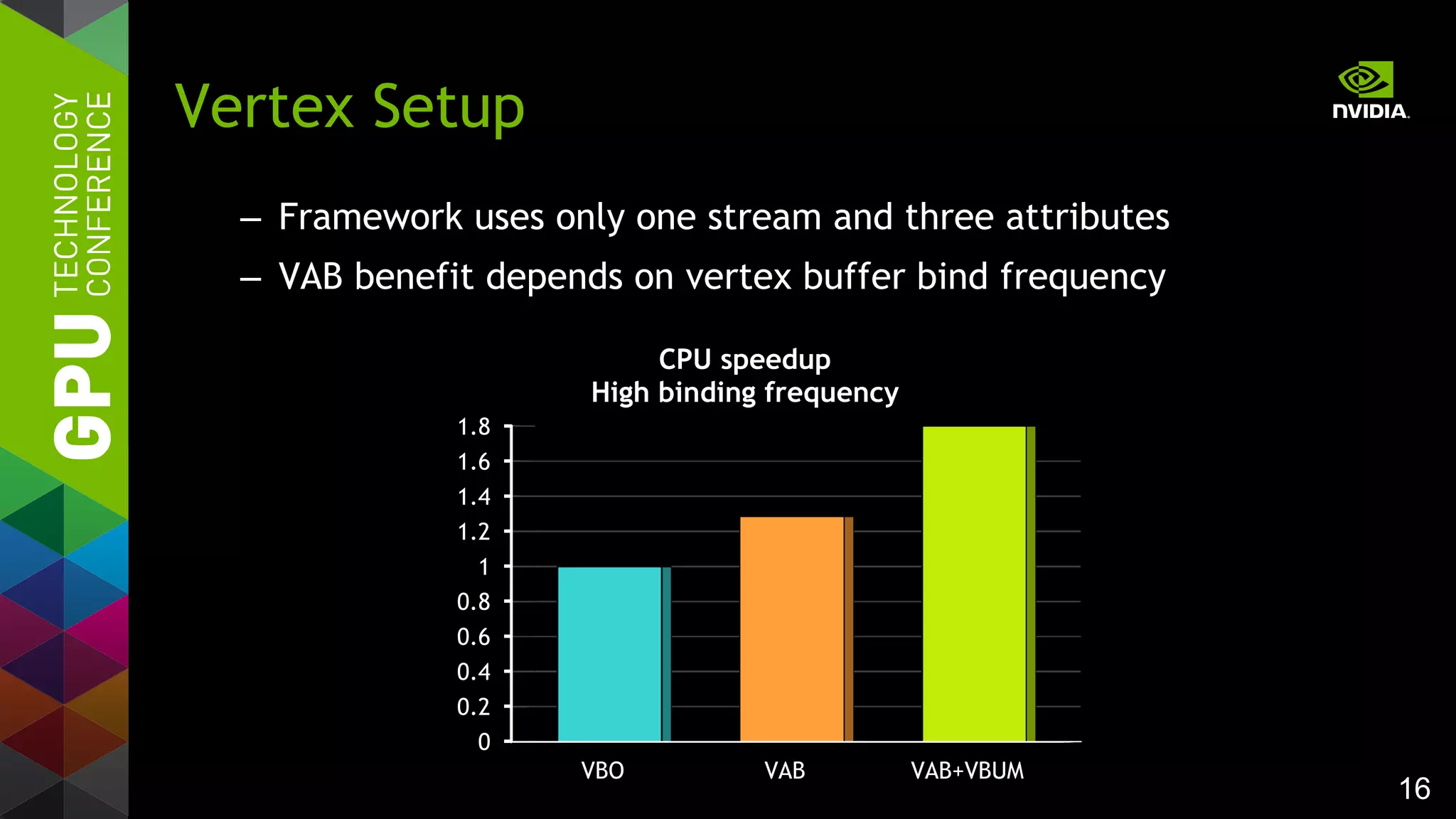
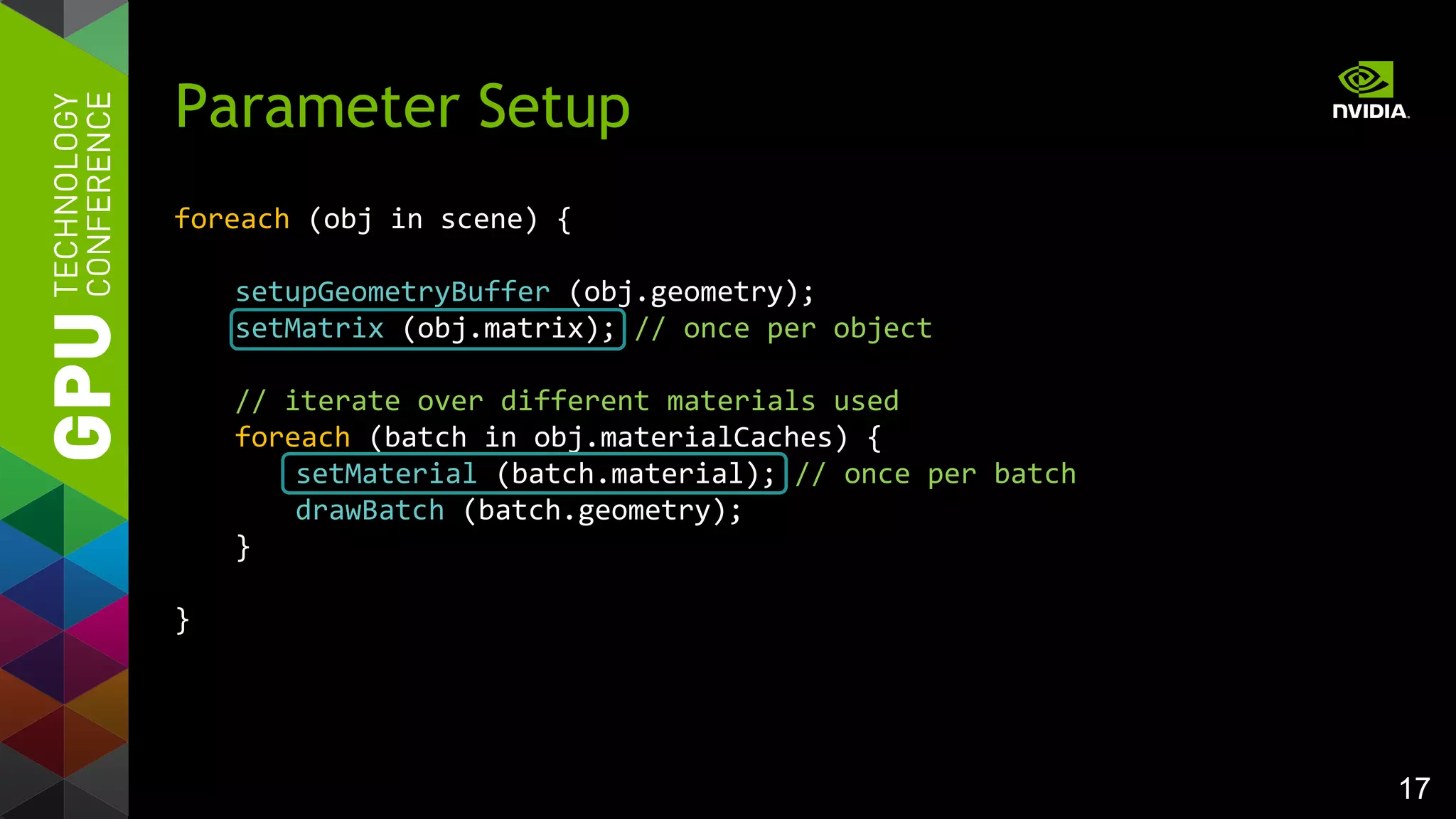
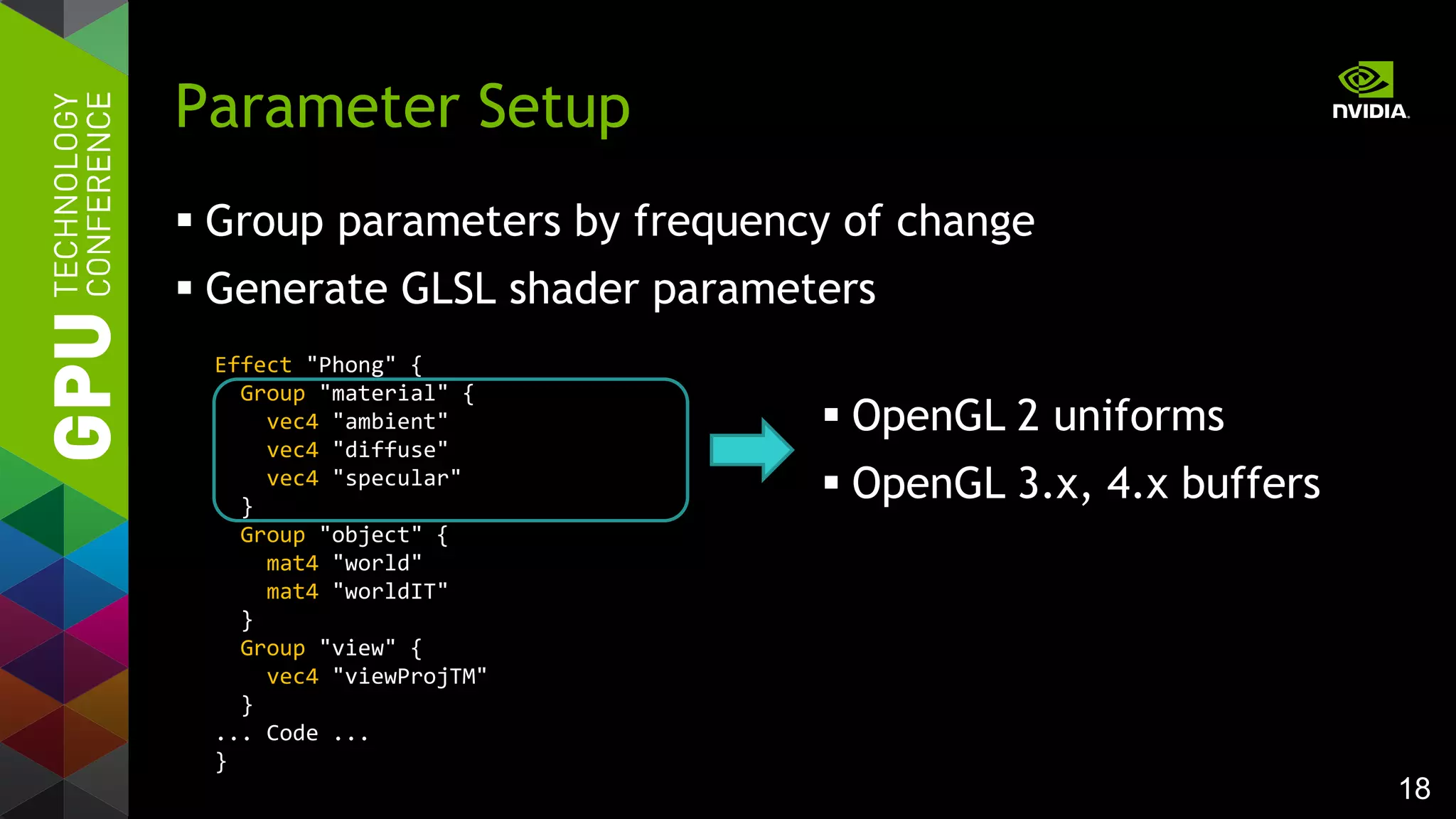
![19
glUniform (2.x)
– one glUniform per parameter
(simple)
– one glUniform array call for all
parameters (ugly)
Uniform
// matrices
uniform mat4 matrix_world;
uniform mat4 matrix_worldIT;
// material
uniform vec4 material_diffuse;
uniform vec4 material_emissive;
...
// material fast but „ugly“
uniform vec4 material_data[8];
#define material_diffuse material_data[0]
...](https://image.slidesharecdn.com/tuq9luulsosocsjbihx7-signature-3a2a87be8e63e1de55b788f7f79aaa7579735627c4872928bfa368ed8b08f16a-poli-150113234003-conversion-gate02/75/OpenGL-4-4-Scene-Rendering-Techniques-19-2048.jpg)
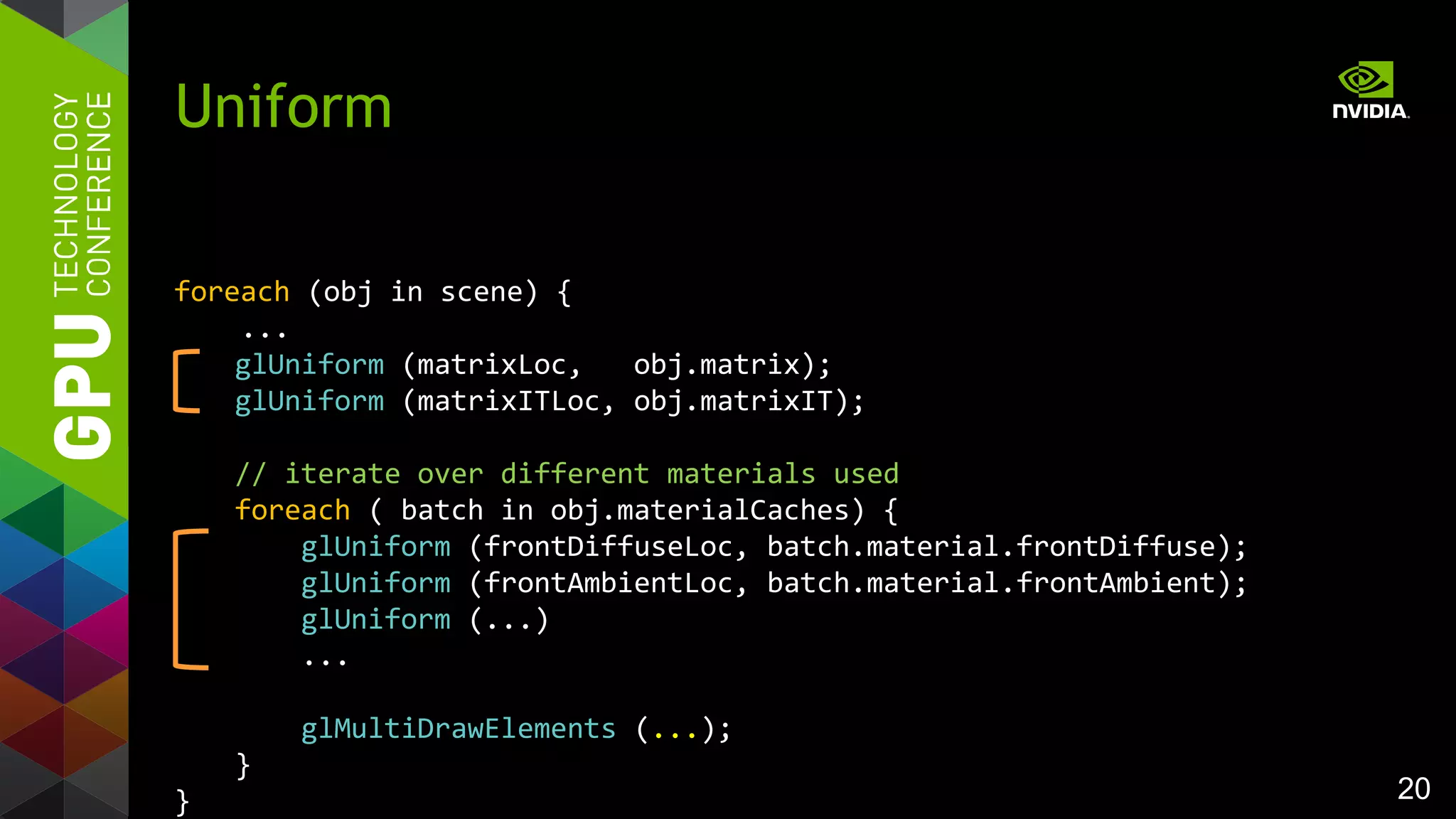
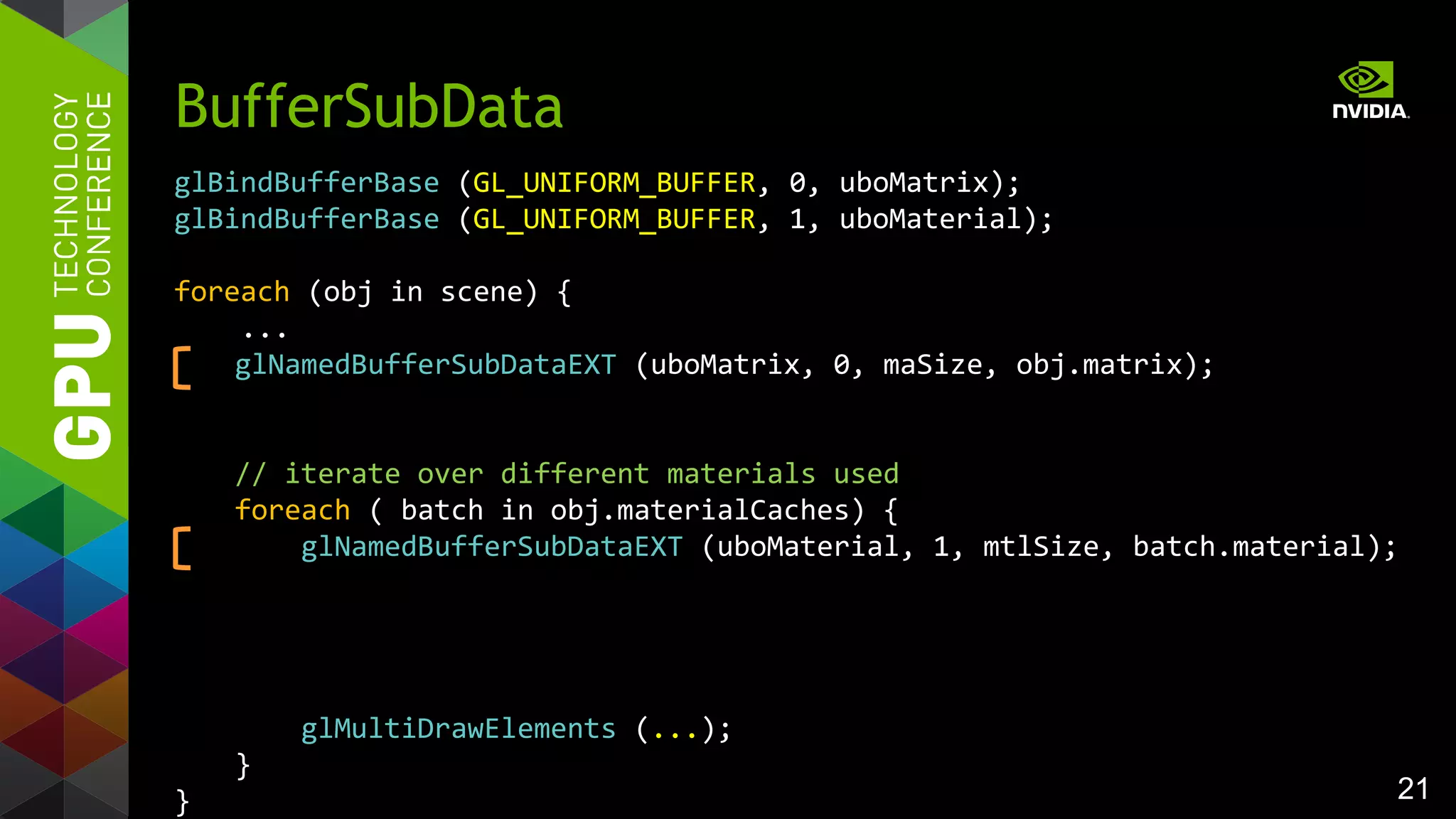
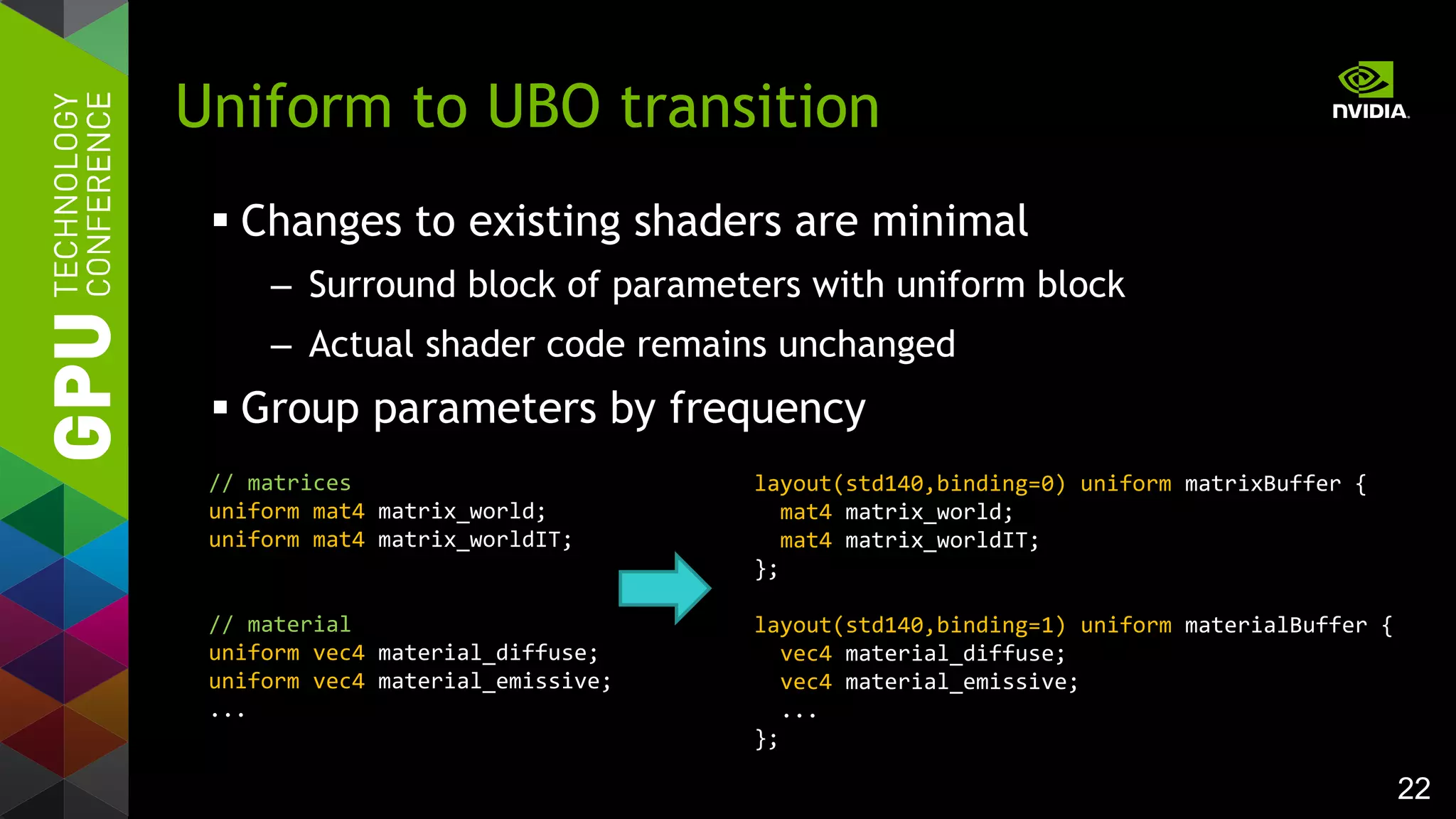

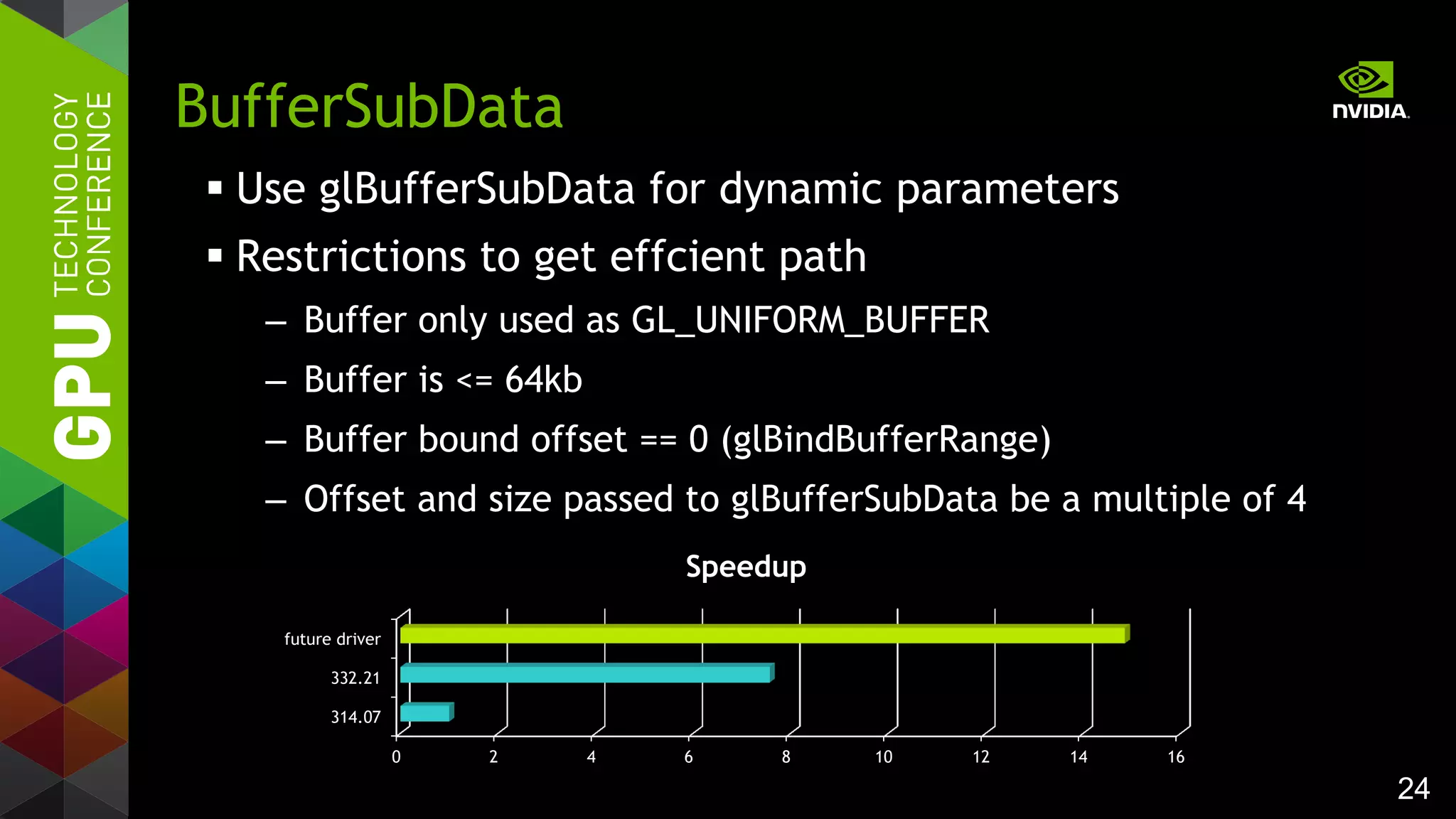
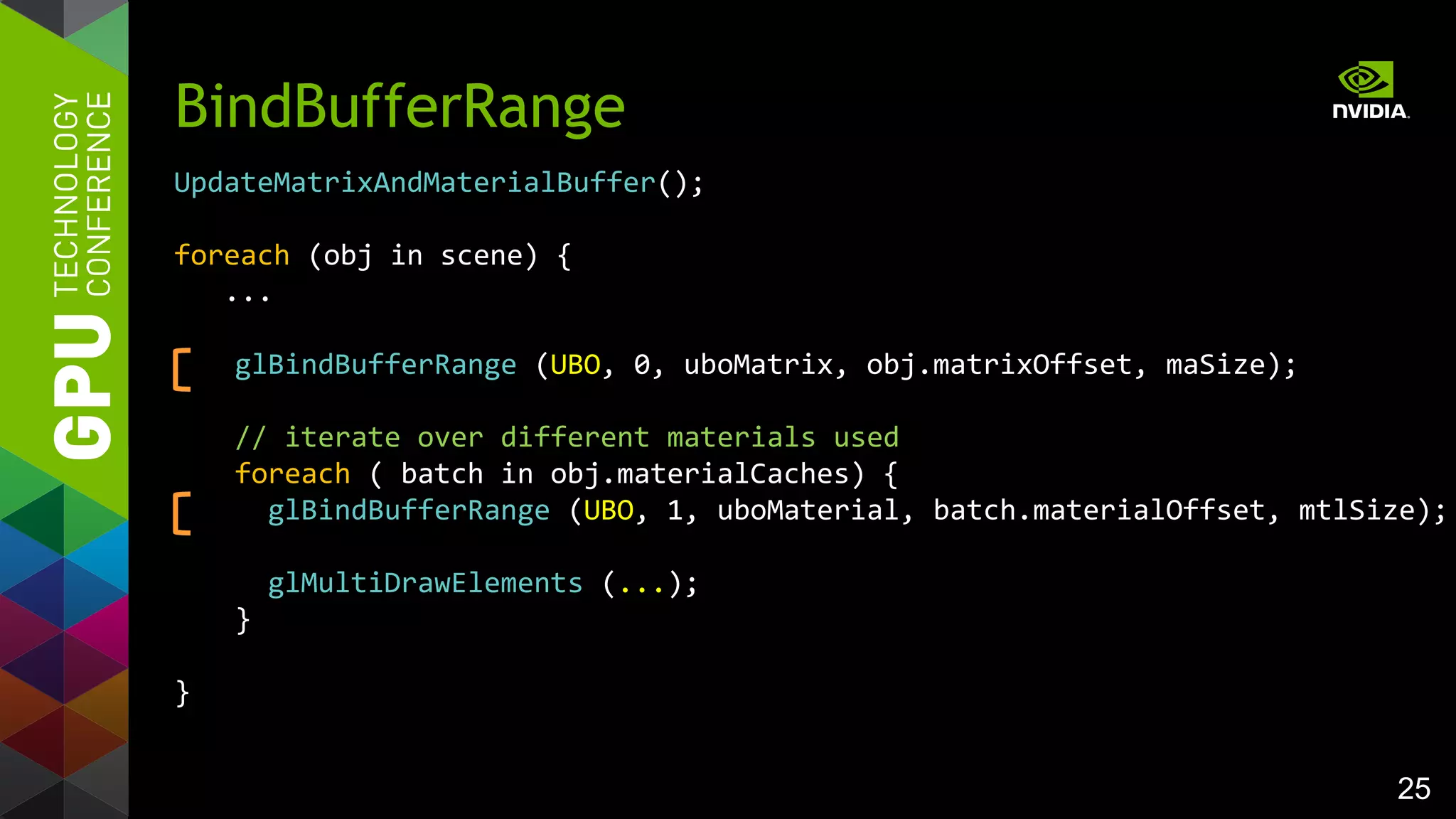
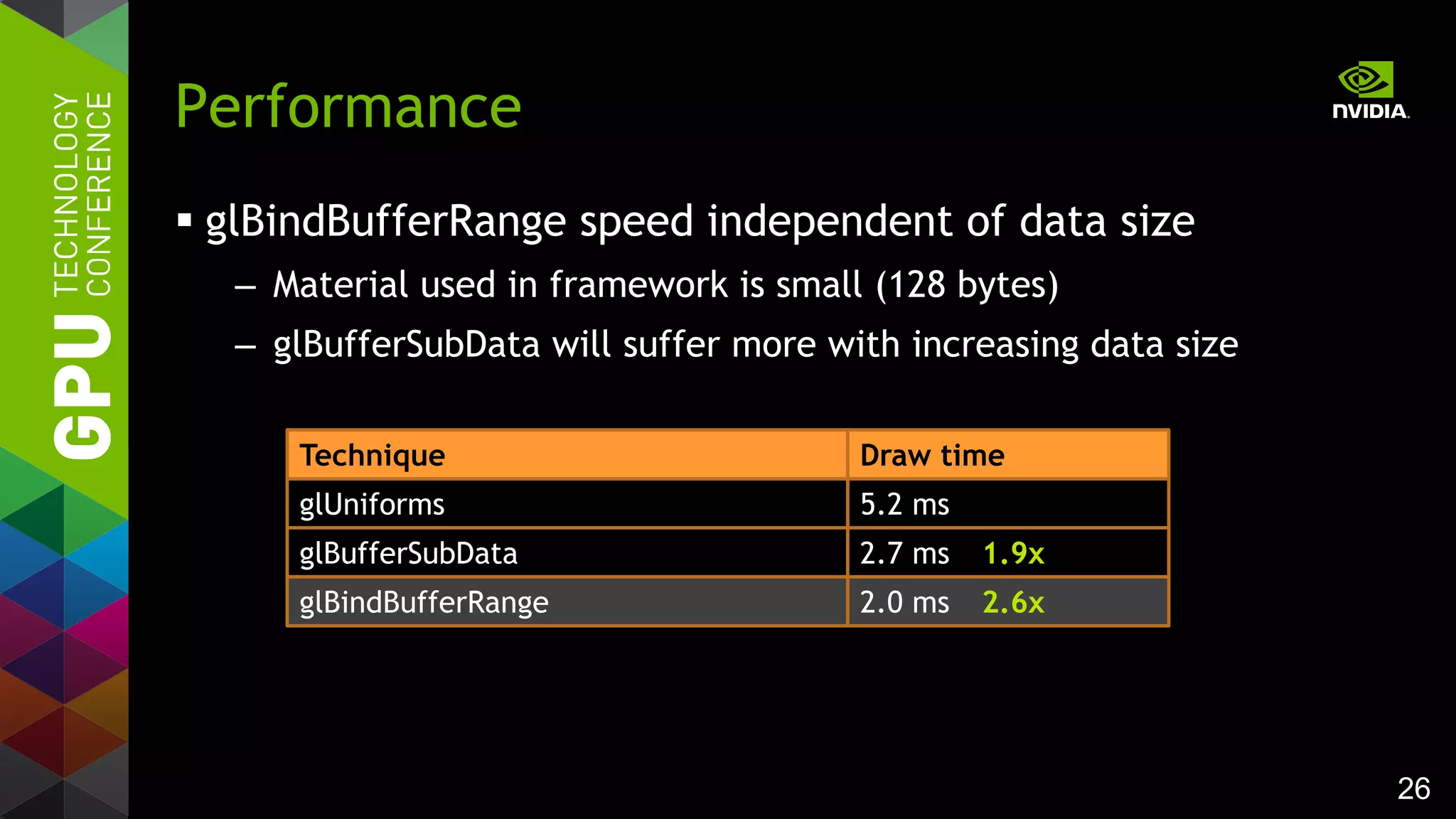
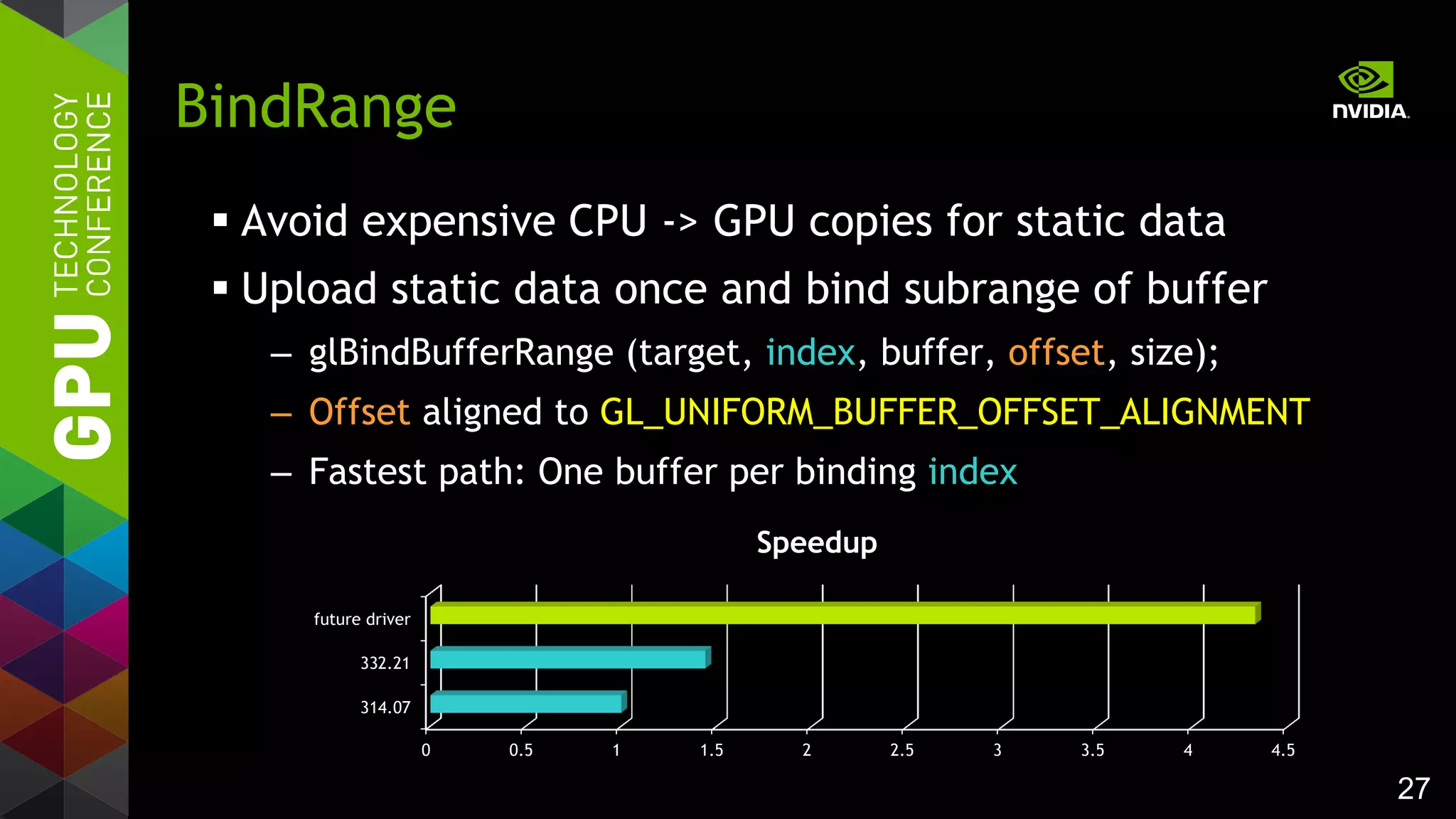

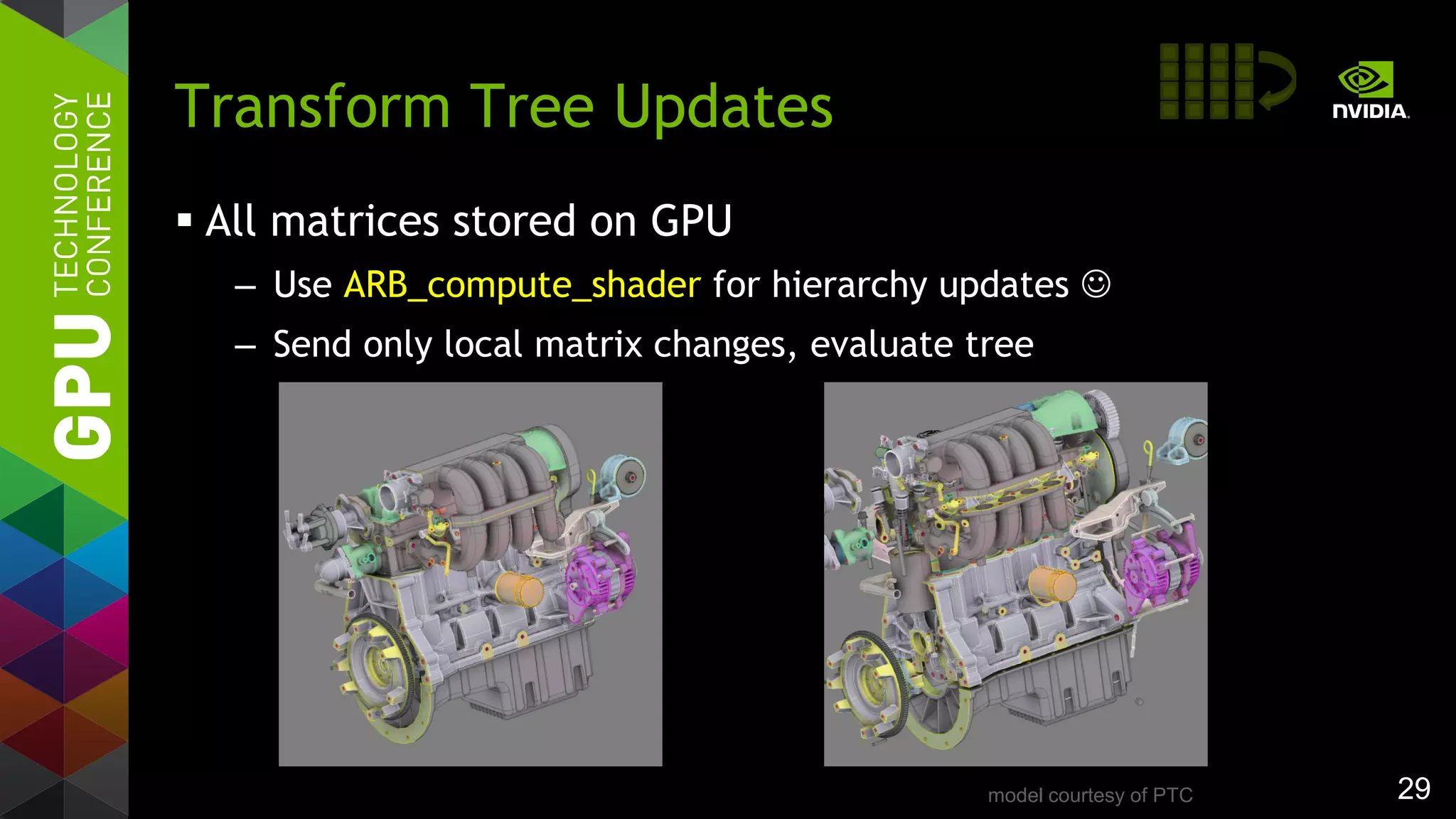
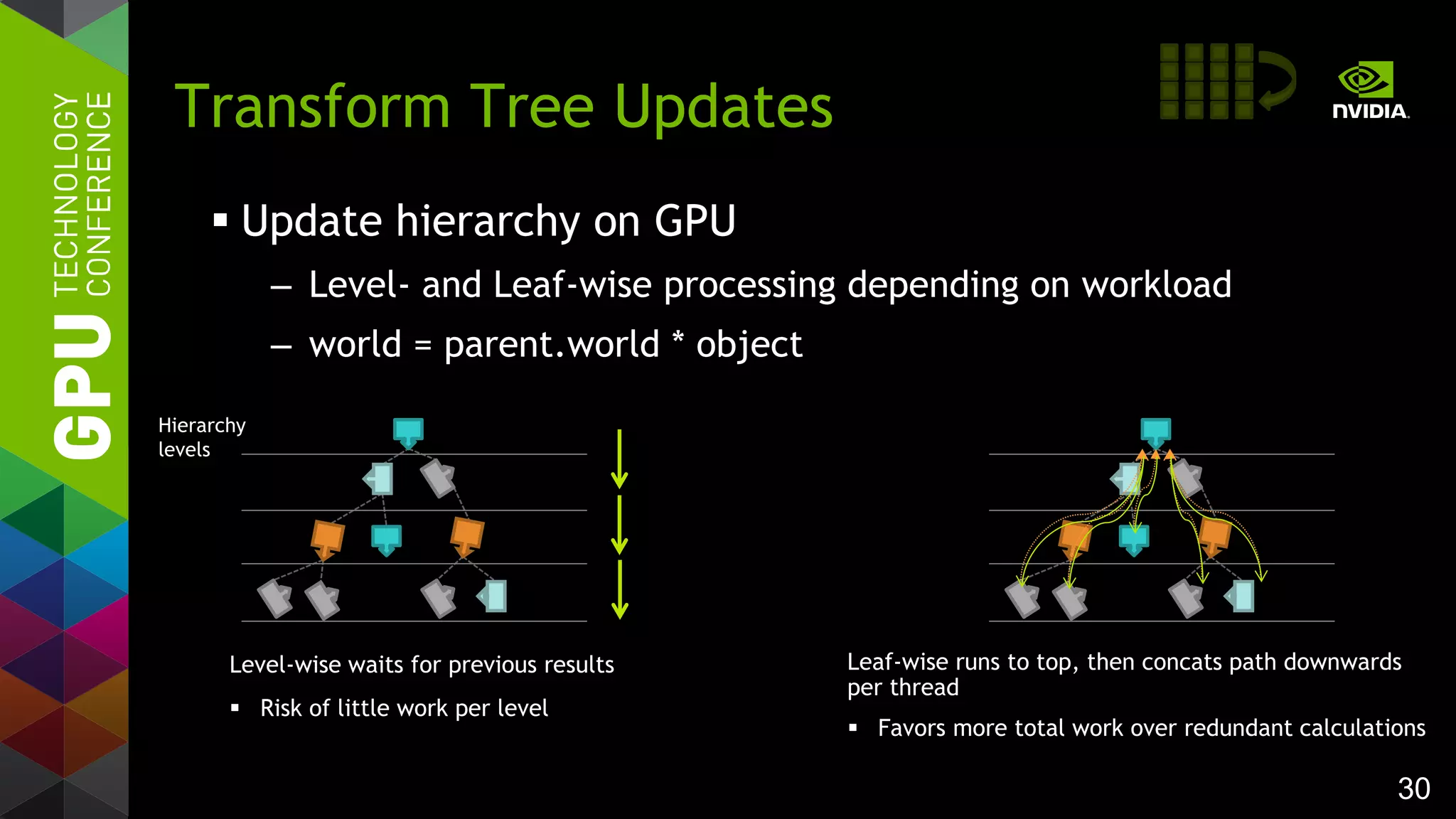
![31
– TextureBufferObject
(TBO) for matrices
– UniformBufferObject
(UBO) with array data
to save binds
– Assignment indices
passed as vertex
attribute or uniform
– Caveat: costs for
indexed fetch
Indexed in vec4 oPos;
uniform samplerBuffer matrixBuffer;
uniform materialBuffer {
Material materials[512];
};
in ivec2 vAssigns;
flat out ivec2 fAssigns;
// in vertex shader
fAssigns = vAssigns;
worldTM = getMatrix (matrixBuffer,
vAssigns.x);
wPos = worldTM * oPos;
...
// in fragment shader
color = materials[fAssigns.y].color;
...](https://image.slidesharecdn.com/tuq9luulsosocsjbihx7-signature-3a2a87be8e63e1de55b788f7f79aaa7579735627c4872928bfa368ed8b08f16a-poli-150113234003-conversion-gate02/75/OpenGL-4-4-Scene-Rendering-Techniques-31-2048.jpg)

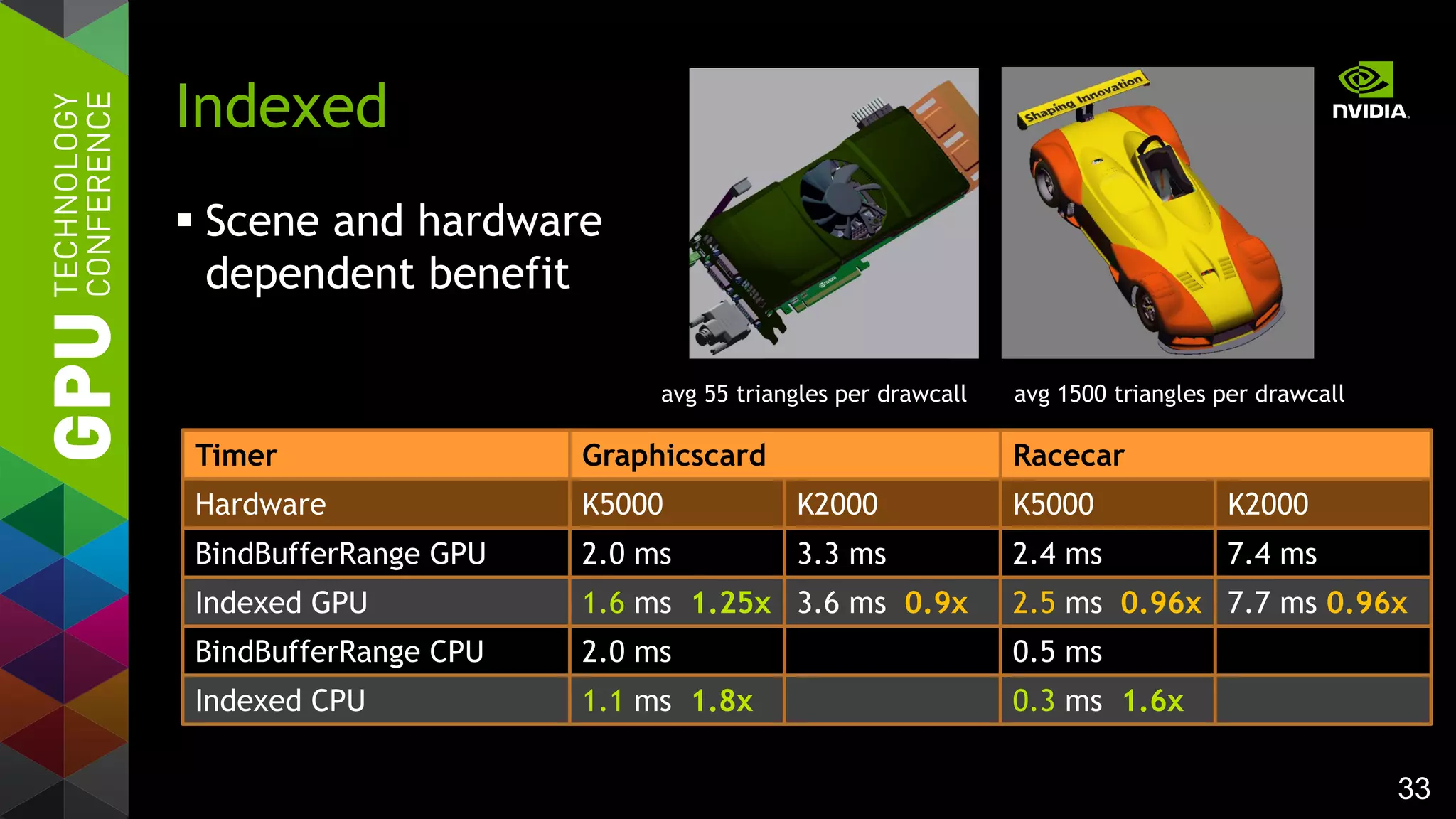
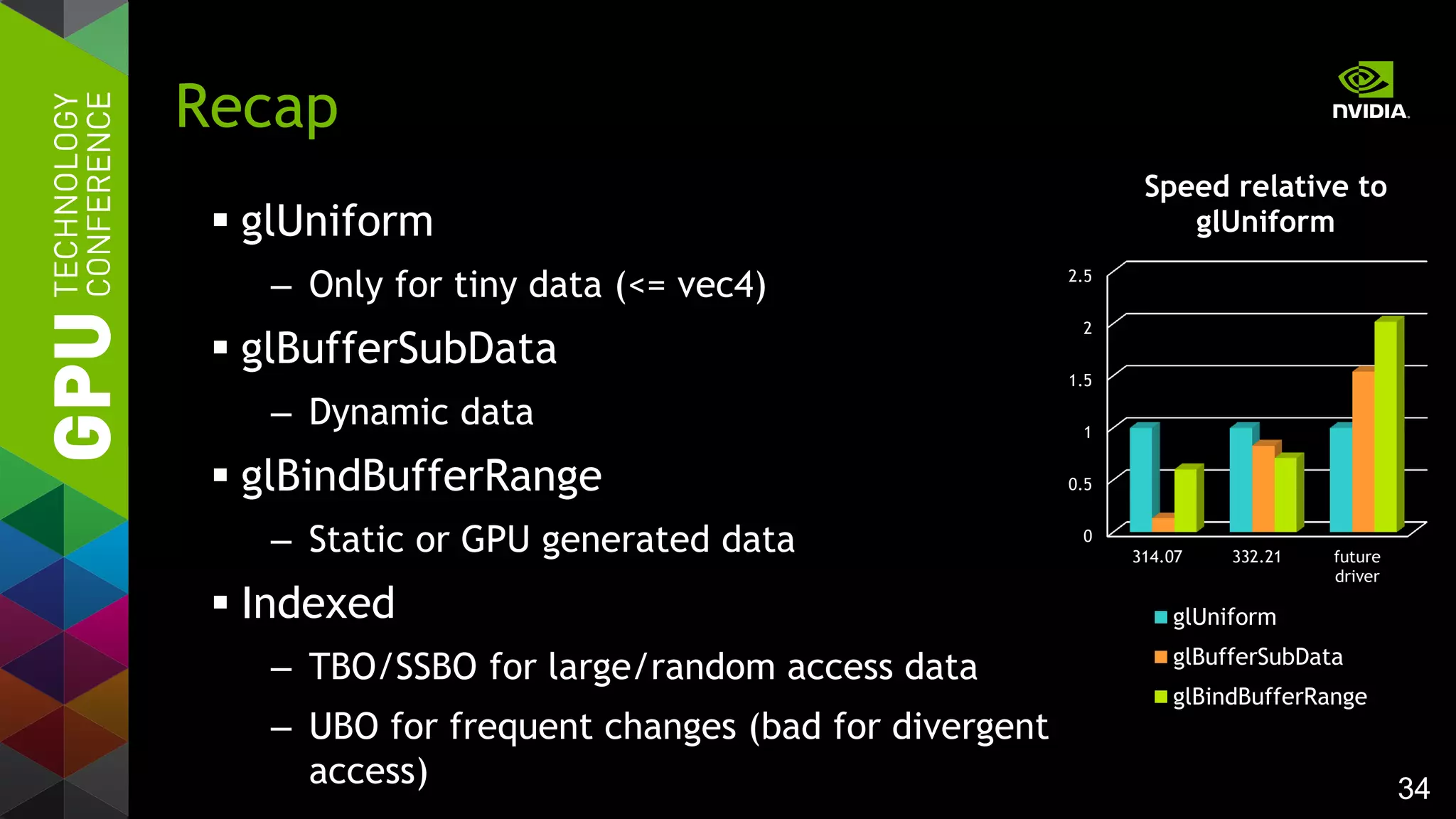
![35
Combine even further
– Use MultiDrawIndirect for single
drawcall
– Can store array of drawcalls on GPU
Multi Draw Indirect
Grouped and „grown“ drawcalls
Single drawcall with material/matrix
changesDrawElementsIndirect
{
GLuint count;
GLuint instanceCount;
GLuint firstIndex;
GLint baseVertex;
GLuint baseInstance;
}
DrawElementsIndirect object.drawCalls[ N ];
encodes material/matrix assignment](https://image.slidesharecdn.com/tuq9luulsosocsjbihx7-signature-3a2a87be8e63e1de55b788f7f79aaa7579735627c4872928bfa368ed8b08f16a-poli-150113234003-conversion-gate02/75/OpenGL-4-4-Scene-Rendering-Techniques-35-2048.jpg)
![36
Parameters:
– TBO and UBO as before
– ARB_shader_draw_parameters
for gl_BaseInstanceARB access
– Caveat:
Currently slower than vertex-
divisor technique shown GTC
2013 for very low primitive
counts (improvement being
investigated)
Multi Draw Indirect
uniform samplerBuffer matrixBuffer;
uniform materialBuffer {
Material materials[256];
};
// encoded assignments in 32-bit
ivec2 vAssigns =
ivec2 (gl_BaseInstanceARB >> 16,
gl_BaseInstanceARB & 0xFFFF);
flat out ivec2 fAssigns;
// in vertex shader
fAssigns = vAssigns;
worldTM = getMatrix (matrixBuffer,
vAssigns.x);
...
// in fragment shader
color = materials[fAssigns.y].diffuse...](https://image.slidesharecdn.com/tuq9luulsosocsjbihx7-signature-3a2a87be8e63e1de55b788f7f79aaa7579735627c4872928bfa368ed8b08f16a-poli-150113234003-conversion-gate02/75/OpenGL-4-4-Scene-Rendering-Techniques-36-2048.jpg)
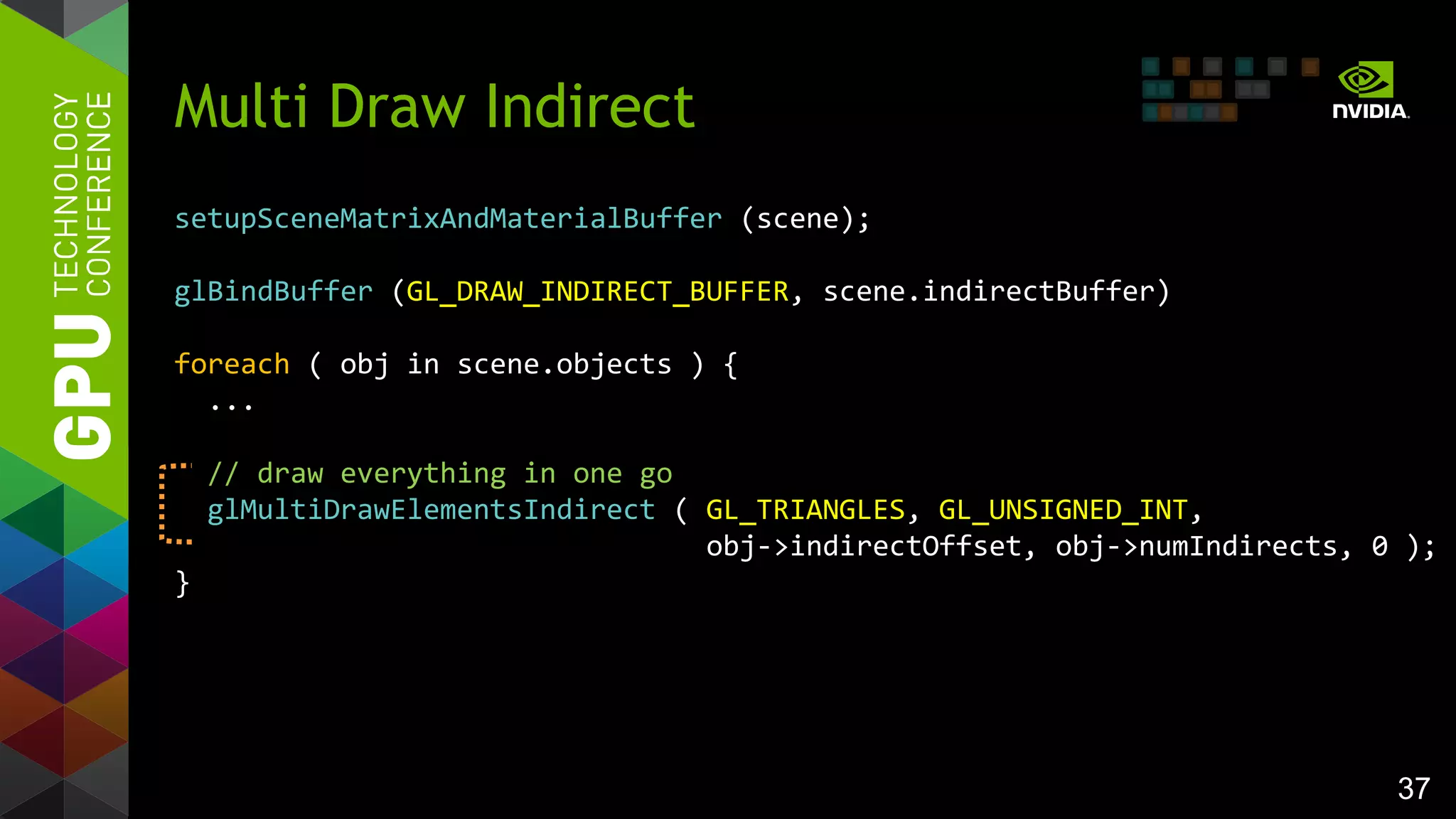

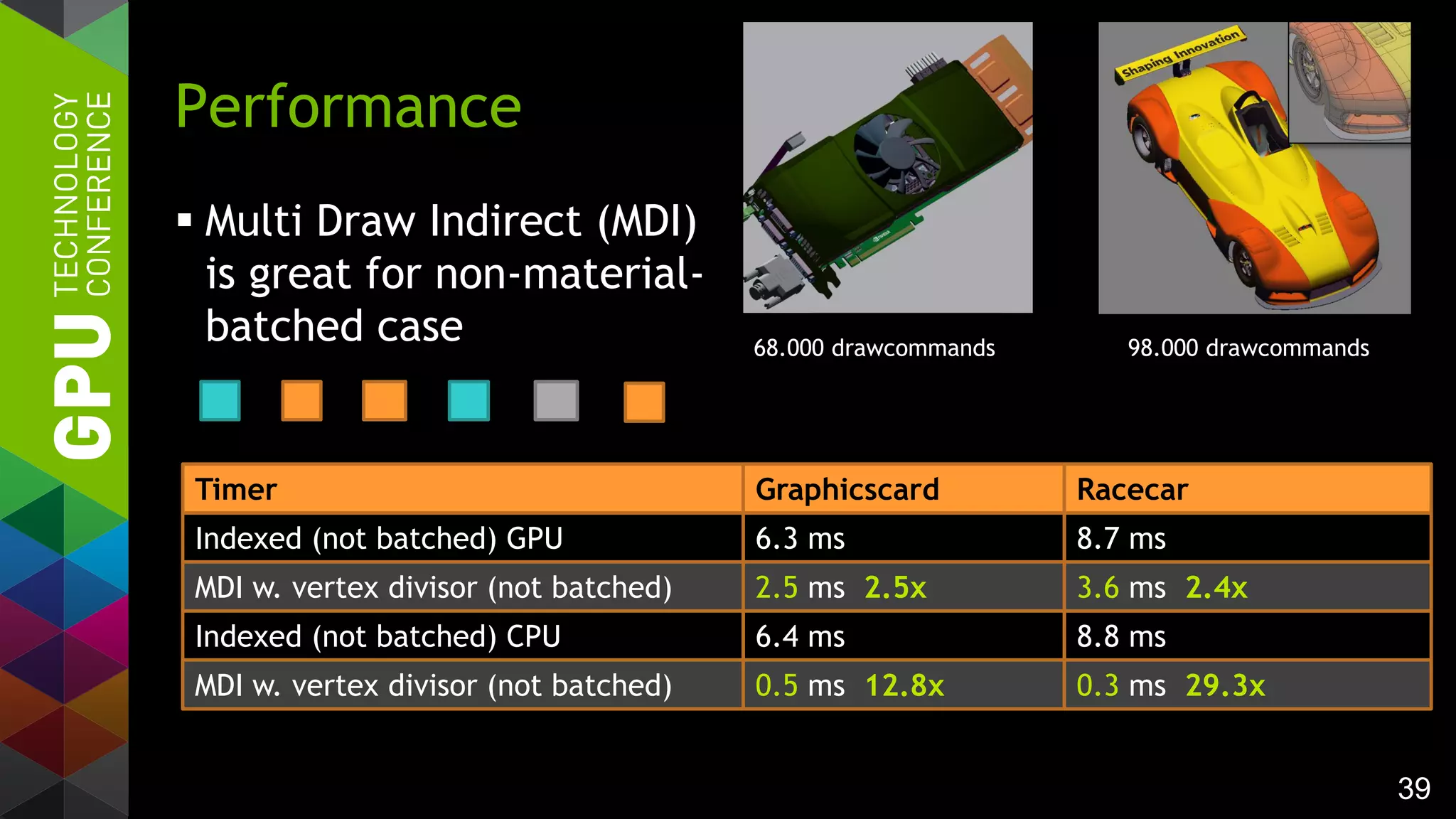
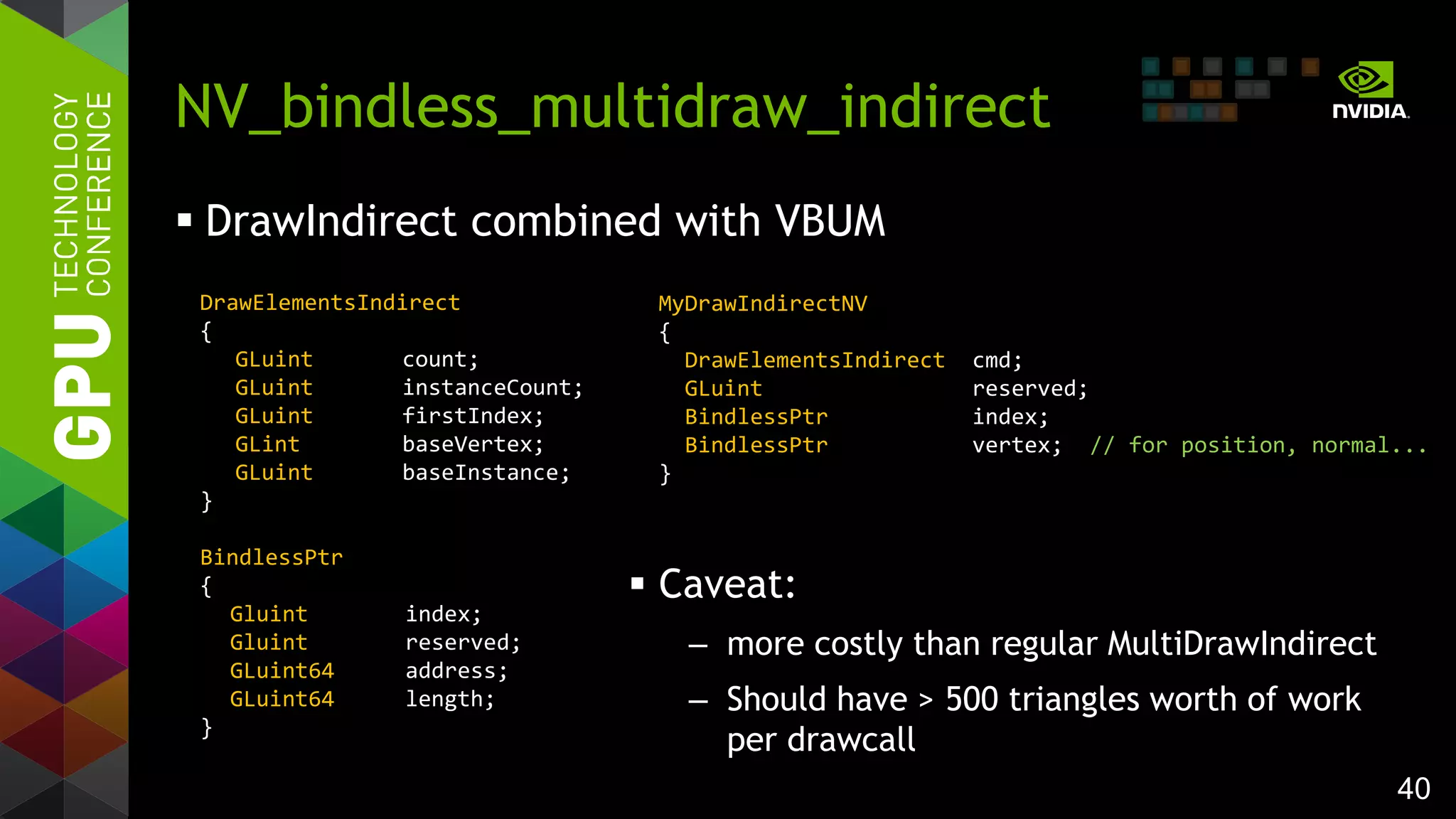
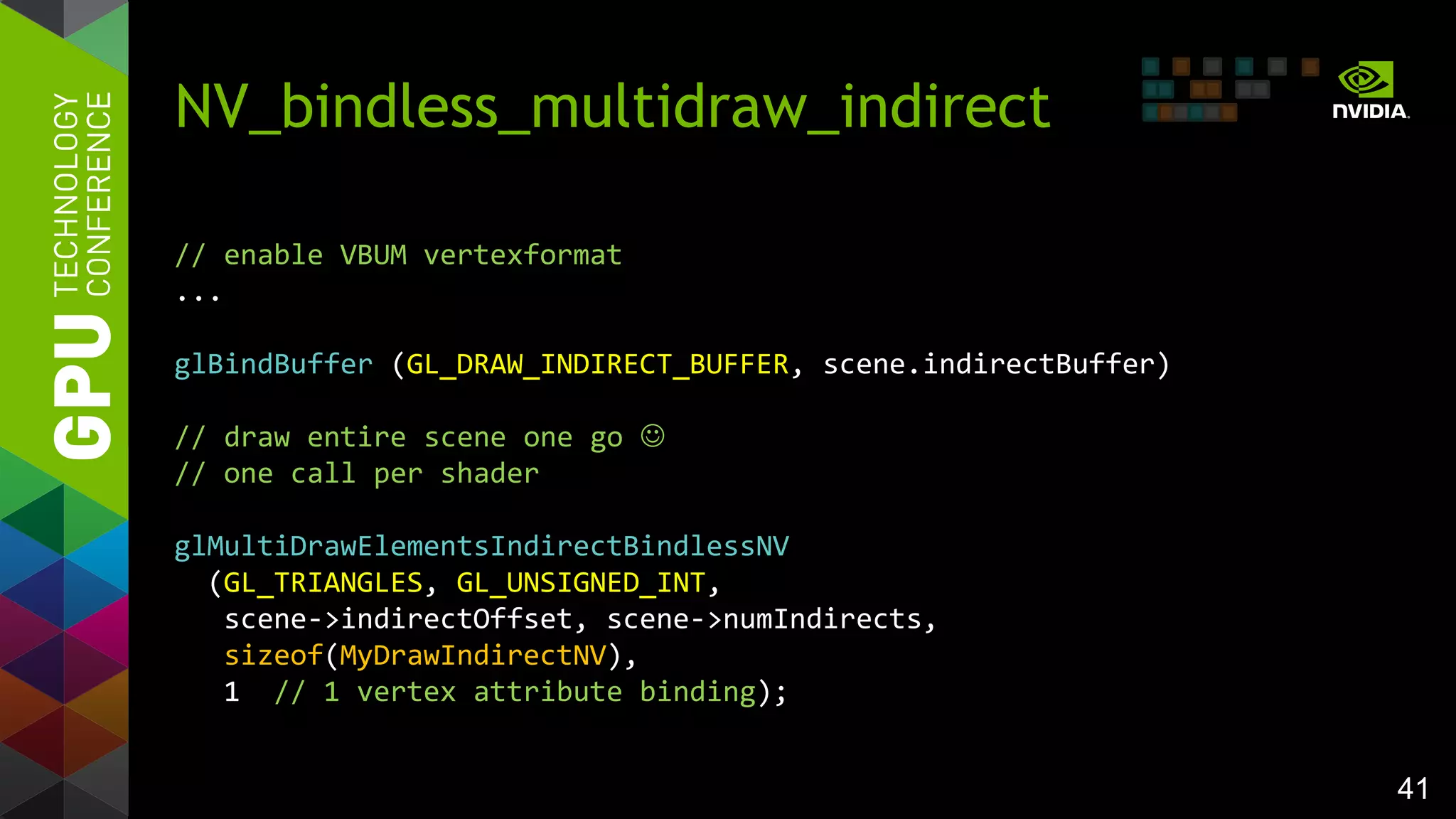

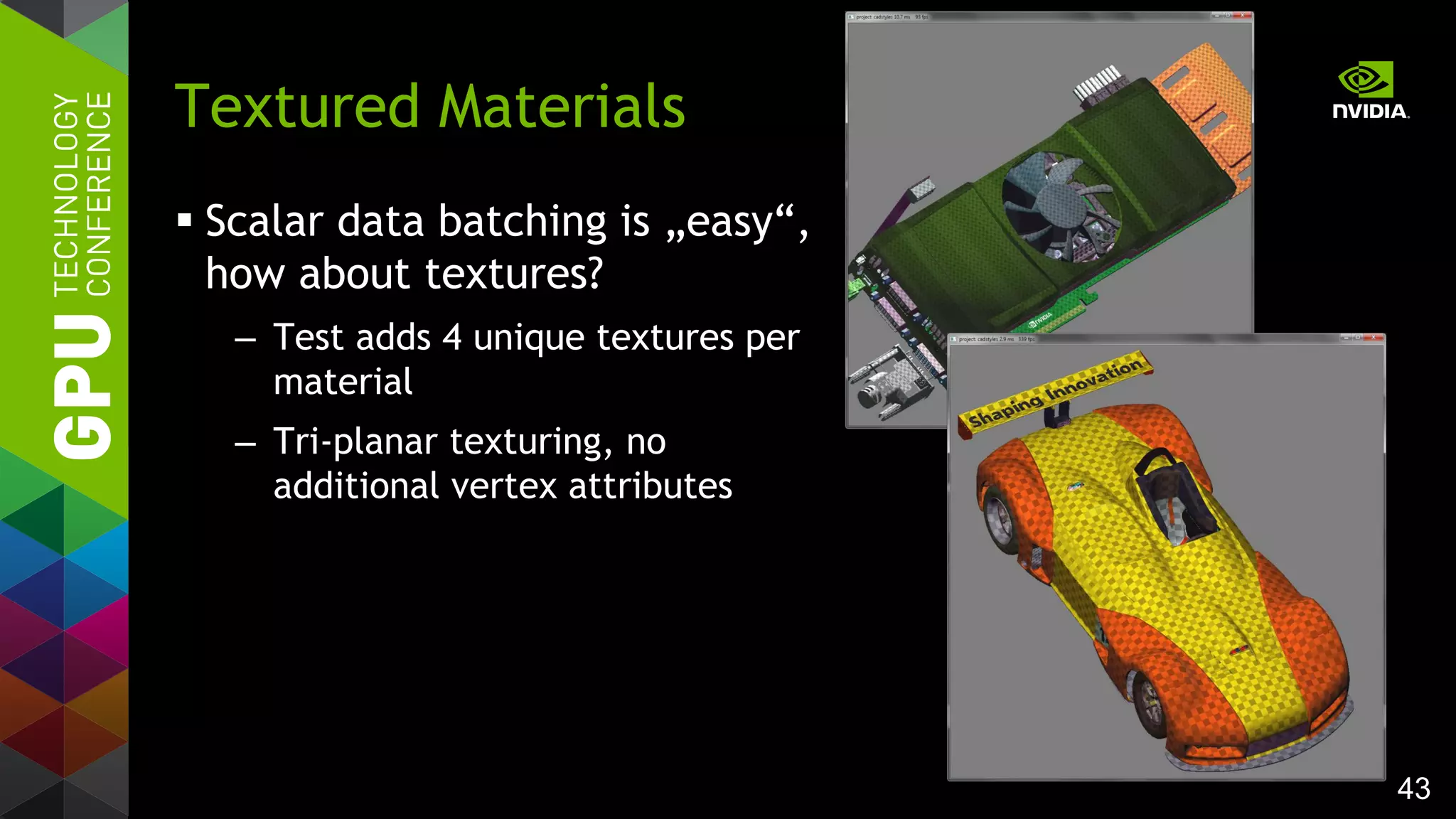
![44
ARB_multi_bind aeons in the making, finally here (4.4 core)
Textured Materials
// NEW ARB_multi_bind
glBindTextures (0, 4, textures);
// Alternatively EXT_direct_state_access
glBindMultiTextureEXT ( GL_TEXTURE0 + 0, GL_TEXTURE_2D, textures[0]);
glBindMultiTextureEXT ( GL_TEXTURE0 + 1, GL_TEXTURE_2D, textures[1]);
...
// classic selector way
glActiveTexture (GL_TEXTURE0 + 0);
glBindTexture (GL_TEXTURE_2D, textures[0]);
glActiveTexture (GL_TEXTURE0 + 1 ...
...](https://image.slidesharecdn.com/tuq9luulsosocsjbihx7-signature-3a2a87be8e63e1de55b788f7f79aaa7579735627c4872928bfa368ed8b08f16a-poli-150113234003-conversion-gate02/75/OpenGL-4-4-Scene-Rendering-Techniques-44-2048.jpg)
![45
NV/ARB_bindless_texture
– Manage residency
uint64 glGetTextureHandle (tex)
glMakeTextureHandleResident (hdl)
– Faster binds
glUniformHandleui64ARB (loc, hdl)
– store texture handles as 64bit
values inside buffers
Textured Materials
// NEW ARB_bindless_texture stored inside
buffer!
struct MaterialTex {
sampler2D tex0; // can be in struct
sampler2D tex1;
...
};
uniform materialTextures {
MaterialTex texs[128];
};
// in fragment shader
flat in ivec2 fAssigns;
...
color = texture ( texs[fAssigns.y] .tex0,
uv);](https://image.slidesharecdn.com/tuq9luulsosocsjbihx7-signature-3a2a87be8e63e1de55b788f7f79aaa7579735627c4872928bfa368ed8b08f16a-poli-150113234003-conversion-gate02/75/OpenGL-4-4-Scene-Rendering-Techniques-45-2048.jpg)
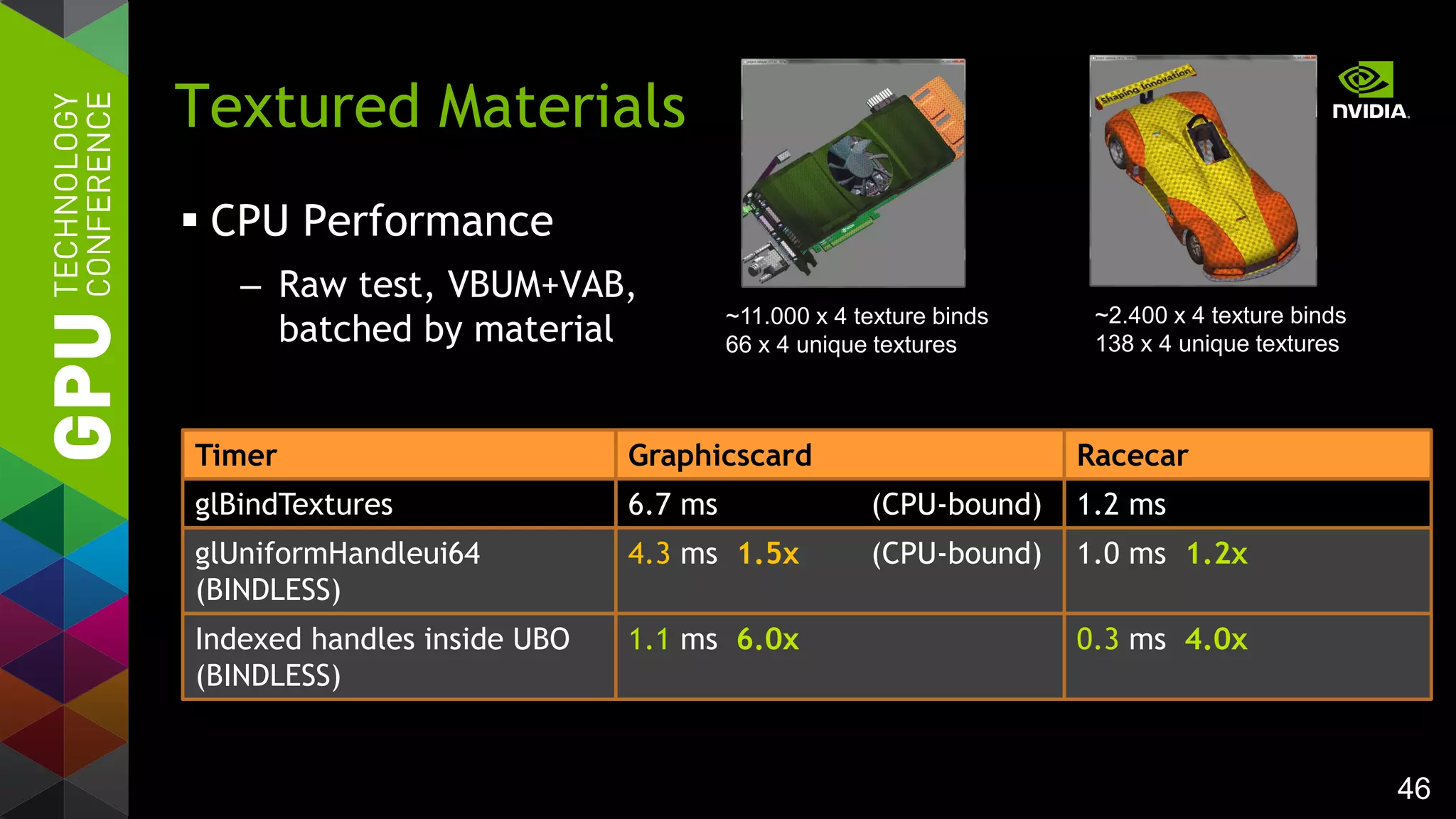
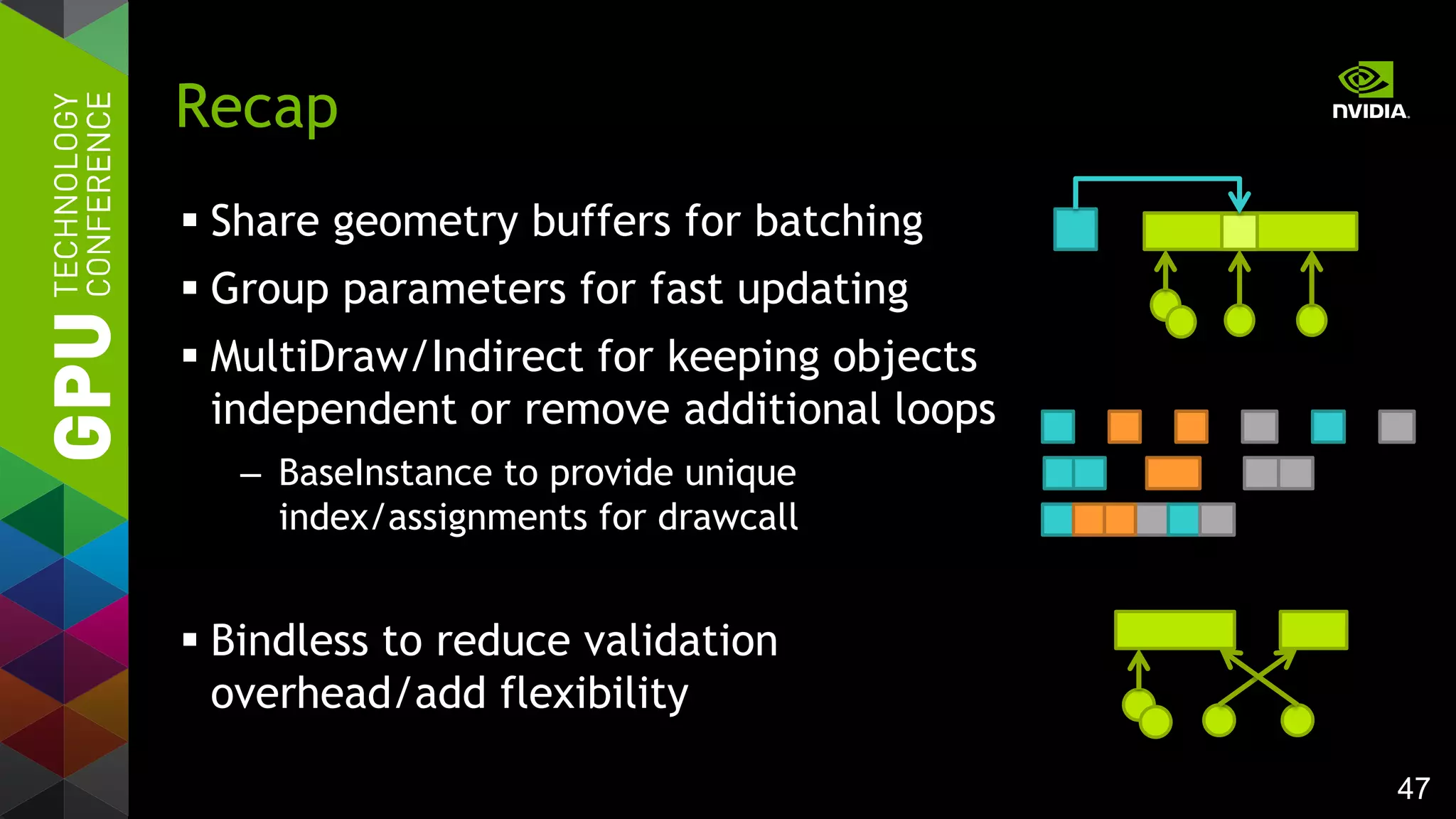

![49
GPU friendly processing
– Matrix and bbox buffer, object buffer
– XFB/Compute or „invisible“ rendering
– Vs. old techniques: Single GPU job for ALL objects!
Results
– „Readback“ GPU to Host
Can use GPU to pack into bit stream
– „Indirect“ GPU to GPU
Set DrawIndirect‘s instanceCount to 0 or 1
GPU Culling Basics
0,1,0,1,1,1,0,0,0
buffer cmdBuffer{
Command cmds[];
};
...
cmds[obj].instanceCount = visible;](https://image.slidesharecdn.com/tuq9luulsosocsjbihx7-signature-3a2a87be8e63e1de55b788f7f79aaa7579735627c4872928bfa368ed8b08f16a-poli-150113234003-conversion-gate02/75/OpenGL-4-4-Scene-Rendering-Techniques-49-2048.jpg)
![50
OpenGL 4.2+
– Depth-Pass
– Raster „invisible“ bounding boxes
Disable Color/Depth writes
Geometry Shader to create the three
visible box sides
Depth buffer discards occluded
fragments (earlyZ...)
Fragment Shader writes output:
visible[objindex] = 1
Occlusion Culling
// GLSL fragment shader
// from ARB_shader_image_load_store
layout(early_fragment_tests) in;
buffer visibilityBuffer{
int visibility[]; // cleared to 0
};
flat in int objectID; // unique per box
void main()
{
visibility[objectID] = 1;
// no atomics required (32-bit write)
}
Passing bbox fragments
enable object
Algorithm by
Evgeny Makarov, NVIDIA
depth
buffer](https://image.slidesharecdn.com/tuq9luulsosocsjbihx7-signature-3a2a87be8e63e1de55b788f7f79aaa7579735627c4872928bfa368ed8b08f16a-poli-150113234003-conversion-gate02/75/OpenGL-4-4-Scene-Rendering-Techniques-50-2048.jpg)

![52
Culling Readback vs Indirect
0
500
1000
1500
2000
2500
readback indirect NVindirect
Timeinmicroseconds[us] Indirect not yet as efficient to
process „invisible“ commands
For readback results, CPU has to
wait for GPU idle, and GPU may
remain idle until new work
Lower is
Better
GPU
CPU
GPU time
without culling
GPU time optimum
with culling](https://image.slidesharecdn.com/tuq9luulsosocsjbihx7-signature-3a2a87be8e63e1de55b788f7f79aaa7579735627c4872928bfa368ed8b08f16a-poli-150113234003-conversion-gate02/75/OpenGL-4-4-Scene-Rendering-Techniques-52-2048.jpg)
